Tuesday, April 30, 2019
Samsung Galaxy A80 vs Oppo Reno vs Honor View 20: which is the best smartphone for your kid?
Official release date for Oculus Quest, Oculus Rift S is May 21
Oculus has finally told us the release date for the new Oculus Rift S and standalone Oculus Quest headset that will be available starting on May 21.
Both headsets will be available for $399 / £399 (around AU$730) and are available for pre-order starting today.
Facebook CEO Mark Zuckerberg made the announcement of the Rift S's arrival during Facebook's' F8 2019 event that was held today in San Jose, Calif. right outside the company's main headquarters in Menlo Park.
Previously, Oculus has announced that the Quest will arrive with more than 50 titles available on day one, while the Rift S will have access to every title in the Oculus store that can be played with the previous-gen Rift headset.
Developing...
from TechRadar - All the latest technology news http://bit.ly/2GTRI9G
via IFTTT
Best 3D printers of 2019
Over half of businesses have suffered a data breach
IT professionals are still struggling to secure their organizations according to new research from McAfee which revealed that 61 percent have experienced a data breach at their current employer.
The firm's new Grand Theft Data II – The Drivers and Shifting State of Data Breaches report surveyed IT professionals from Australia, Canada, France, Germany, India, Singapore, the US and the UK across a wide range of industries to learn more about today's security landscape.
The report found that data breaches are also becoming more serious as cybercriminals continue to target intellectual property putting the reputation of company's brands at risk and increasing their financial liability.
- The true cost of a data breach
- McAfee and Dell team up to protect consumers from growing cyber threats
- Remote working is leading to a rise in data breaches
McAfee's study shows the need for a cybersecurity strategy that includes implementing security solutions combined with employee training and an overall culture of security throughout the organization to reduce future breaches.
Severity of data breaches
The report also revealed that data is now being stolen using a wider range of methods with no single technique dominating the industry. Database leaks, cloud applications and removable USB drivers were the top vectors used to exfiltrate data.
McAfee found that personally identifiable information (PII) and intellectual property (IP) are now tied as the data categories with the highest potential impact to 43 percent of respondents. PII is of greater concern in Europe (49%) due to the recent enforcement date of GDPR.
When it came to taking responsibility for a breach, 55 percent of IT professionals believe that c-level executives should lose their job if a breach is serious enough though 61 percent also said that the c-level executives they work with expect more lenient security policies for themselves.
Vice president and chief technical strategist at McAfee, Candace Worley offered advice on how organizations can better protect themselves from data breaches, saying:
“Threats have evolved and will continue to become even more sophisticated. Organisations need to augment security measures by implementing a culture of security and emphasising that all employees are part of an organisation’s security posture, not just the IT team. To stay ahead of threats, it is critical companies provide a holistic approach to improving security process by not only utilising an integrated security solution but also practicing good security hygiene.”
- We've also highlighted the best disaster recovery services
from TechRadar - All the latest technology news http://bit.ly/2V493FG
via IFTTT
Pokémon Go updates: all the news and rumors for what's coming next
Pokémon Go: the world's first augmented reality app to become a household name. Niantic's mobile AR game is still going strong two years after it first released, with a constant drip of events and updates keeping budding trainers glued to their phones and pounding the streets.
And while it hasn't managed to top the peak of its popularity in 2016, it's still going strong and finding plenty of new ways to improve its player experience.
So what's the latest news for Pokémon Go? As you'd expect, brand new features are being added all the time and community events are still going strong.
So without further ado, here's our guide to all the latest Pokémon Go news and updates.
- Pokémon Go tips and tricks: how to get better at the game
- How to fix the biggest problems with Pokémon Go
- Pokémon Gone: how Pokémon Go can bring back lapsed trainers

Pokémon Go news and Pokémon Go updates
- What's new? Pokémon Go has released three legendary Pokémon into the game
Niantic has released the rare Legendary Lake Guardian Trio of Azelf, Mesprit, Uxie into Pokémon Go.
To date Legendaries have only appeared in Pokémon Go as special research or in Tier 5 raids
As far as we know, players have only reported one of the illusive trio per region with Azelf residing in the Americas, Uxie in Asia-Pacific and Mesprit in Europe. So unless you fancy traveling the globe, you are unlikely to catch all three.
Check out Niantic's tweet below:
When's the next Pokémon Go event?
There currently isn't an in-game event active in Pokémon Go. However, Niantic are gearing up for Pokémon Go Fest Chicago which will run from June 13 to 19, 2019.
Check out the official Pokémon Go events page for more details.
When's the next Pokémon Go Community Day?
Pokémon Go's next Community Day takes place on May 19. The featured Pokémon for the event will be Torchic, while the bonuses for the event will be three times catch Stardust and three-hour-long lures. However, we don't know what exclusive move will be available.
Pokémon Go update: what's next?
Niantic hasn't revealed what updates they have planned next, but we expect a summer/winter event in the coming months.
If the Spring event is anything to go by, we will be seeing seasonal content for the summer and winter events - potentially including limited time prizes?
For summer, we imagine there will be a Fire-type event (because it's warm, right?) while winter is likely to see a Ice-type event.
- Check out the best and weirdest Pokémon Go stories so far
Pokémon Go Plus deals
Want to buy yourself a Pokémon Go Plus wearable? Check some of today's best deals down below.
(Image credits: Niantic/Pokémon Company)
from TechRadar - All the latest technology news http://bit.ly/2e1sNQP
via IFTTT
US presidential candidates aren't using basic email security
New research has revealed that almost all of the upcoming 2020 presidential candidates in the US are falling behind when it comes to email security despite the fact that Hillary Clinton's email accounts were targeted and breached by Russian hackers just three years ago.
The email security company Agari confirmed that only the Democratic candidate Elizabeth Warren is using domain-based message authentication, reporting and conformance policy or DMARC to protect her email accounts.
This email security features resides on top of the Sender Policy Framework (SKF) and the DomainKeys Identified Mail (DKIM) security protocols which use cryptography to verify a sender's email and can mark emails as spam or reject them if an email fails to be properly validated.
- Banish those winter blues with email security
- Email security is greater threat than ever
- How to make your email more secure
According to Agari, the other 11 candidates whose email security it investigated, including Bernie Sanders, Joe Biden and presidential incumbent Donald Trump, do not use DMARC to security their campaign domains.
DMARC
By not using DMARC to secure their email accounts, Agari warned that the 2020 presidential candidates risk having their campaigns impersonated in spam campaigns and phishing attacks.
The company's Armen Najarian explained why using DMARC to secure one's email accounts has become increasingly important, saying:
“DMARC is more important than ever because if it had been implemented with the correct policy on the domain used to spearphish John Podesta, then he would have never received the targeted email attack from Russian operatives.”
There has been a slight rise in DMARC adoption by Fortune 500 companies since the beginning of this year. However, while most of the companies use DMARC, Agari said that only 16 percent of the 500 world's richest companies reject or quarantine unvalidated email.
Via TechCrunch
- We've also highlighted the best email providers
from TechRadar - All the latest technology news http://bit.ly/2JbBWsp
via IFTTT
Sea of Thieves update news, DLC, patch notes and more
Swashbuckling has come back in a big way with Rare's sandbox multiplayer pirate adventure, Sea of Thieves. Since first hitting Xbox One and PC in March 2018, the developer has been working on a host of post-launch patches and free DLC – with more staff working on the title now than in the run-up to its original release – and the seafaring title continues to attract more players by offering continual improvements and additional content to the game's community.
According to Rare, within the game's first year, Sea of Thieves players collected and cashed in almost 750 million chests, skulls and items of cargo to amass a collective fortune of 642 billion gold.
As an open-ended online service game, there's plenty more to come. To help you keep on top of what's new and what's coming up, we've put together this handy page which will be updated with all the latest announcements.

As we said in our full Sea of Thieves review:
"Sea of Thieves is still in its early days, but I think it’s off to an extremely strong start. It’s clear that the developers are willing to listen to the players, and I expect we’ll see a great many interesting additions to the game in the coming months.
"It’s worth saying, though, that the game will need these additions – your friends can only add so much variety to a Gold Hoarders' quest before everyone grows weary. As long as Rare is willing to add to this playground, I expect players will be happy to play in it. "
- Sea of Thieves review: check out our complete, in-depth verdict in our full review
Sea of Thieves update news and patch notes
- What's new? The Sea of Thieves Anniversary Update is out now
To celebrate Sea of Thieves' one year anniversary, Rare has rolled out the game's biggest content update to date.
The Sea of Thieves Anniversary Update adds three key new features: The Arena, The Hunter's Call and Tall Tales.
The Arena is a new PvP competitive game mode that sees crews going head-to-head to collect the most loot. Meanwhile, the Hunter's Call is a new Trading Company that gives you more ways to play and progress towards Pirate Legend.
However, arguably the most exciting new feature is Tall Tales - a collection of story-rich quests that are played out in Sea of Thieves' shared world and can be fully experienced by yourself or with your crew. The first collection of Tall Tales will be the Shores of Gold.
In addition, the latest update squashes some bugs and makes a handful of performance improvements.
Check out the Sea of Thieves Anniversary Update release notes.
In addition, Rare is treating players to a host of celebratory rewards such as new Mercenary Voyages, a new Reaper's Run Voyage, Commendations and cosmetics. There's also a special Gilded Mercenary Voyage of Legends for Pirate Legends.
Not enough for you? There's a bunch of special rewards for those who played during the first year such as Captain Bones' Original Pirate Cutlass. While any player who attained Pirate Legend status during the first year will receive a Golden Legendary Tankard, a Golden Legendary Hurdy-Gurdy, a Golden Legendary Blunderbuss and Golden Legendary ship customisations including a Sail, Hull and Figurehead.
How to play Sea of Thieves
Sea of Thieves is now available on PC and Xbox One. It's possible to purchase the game outright, but you can also pick up an Xbox Game Pass subscription where the entire game is included.
If you're not sure whether Sea of Thieves is for you, picking up a Game Pass trial for free and playing the game for a short time through it is a good way to find out.
The game is not a port for PC or Xbox, it works equally on both and supports cross-play. While the console version has locked frame rates of 30fps, the PC version's are unlocked. Mouse, keyboard and controllers are all supported across console and PC.

(Image credits: Rare Ltd.)
- Check out our Sea of Thieves guide for how to survive on the high seas
from TechRadar - All the latest technology news http://bit.ly/2pTF0N6
via IFTTT
Dell XPS 17 may be in the works alongside a dual screen model
Dell is apparently bringing back the bigger-screened XPS 17, as spotted in a leaked product roadmap reportedly found by Tweakers.
Dell's XPS lineup of laptops has stood out for years as a high bar for other laptops to aim at, with the XPS 13 and XPS 15 series consistently among the best laptops on the market.
Today, it's been the better part of a decade since we've seen a Dell XPS 17 laptop. Dell's focus with the XPS line has seemed to be on a blend of portability, performance and design. Of course, 17-inch laptops in the past have been among the least portable laptops, with huge screens flanked by large bezels and considerable weight.
- See our review of the Dell XPS 13
- Check out our Huawei MateBook 13 review
- These are the best Ultrabooks available now
That formula for laptop design has been changing, though, and a future Dell XPS 17 laptop could likely use Dell's InfinityEdge display style to fit a 17-inch display into the form factor of past 15-inch laptops.
More details from the leak
For the XPS 17, the product roadmap leak shows a launch in July of 2020. So, it'll be a long time before we see whether that pans out.
However the XPS 17 isn't alone in the leak. Alongside it, there's a new XPS 15 2019 model slated for a July 2019 launch, which could give us some indication of the validity of this leak. That model also appears to be listed with an 8-core Intel Coffee Lake processor (CPU).
Two new XPS 13 models are also listed, with what seems to be a Intel Comet Lake CPU in the earlier model slated for a September launch and an Intel Ice Lake CPU in the model with a February 2019 launch.
While basic updates to the XPS 15 and XPS 13 line are reasonable to expect, including updates for the XPS 13 2-in-1, one interesting extra in the leak is mention of an XPS Dual Screen lined up for October 2020.
There are no details on what processor will power it, and there's only room for speculation at this point on what it could look like. With the productivity focus of XPS machines, a typical laptop design paired with some kind of slide-out secondary display is feasible, though a design we've really only seen in prototypes like the Razer Project Valkyrie.
The design could also be something like the Lenovo Yoga Book C930, but the idea of offering only a digital keyboard on a productivity-minded machine seems implausible. With any luck, future leaks will give us some more hints.
- These are the best 2-in-1 laptops
Via Liliputing
from TechRadar - All the latest technology news http://bit.ly/2Y1zqsV
via IFTTT
Vodafone found security flaws in Huawei kit years ago
Vodafone has revealed that it found security flaws in equipment provided by Chinese hardware maker Huawei to its Italian business in 2011 and 2012.
The world's second largest mobile operator said that it had found security vulnerabilities in two products though both incidents were quickly resolved by the Chinese firm.
Huawei has faced increased scrutiny as the US has told its allies not to use its technology over concerns of Chinese spying. Back in January, Vodafone paused the deployment of the firm's equipment in its core networks as it waits for Western governments to give the Chinese company full security clearance.
- Huawei revenue soars despite US allegations and restrictions
- Vodafone: UK Huawei ban would be disproportionate
- Huawei security slammed by UK government report
The British government is still deciding what role Huawei's equipment will play in a future 5G network but it plans to announce its final decision in the next month.
A government report released in March criticized the company for failing to fix long-standing security issues. British security officials said that they had found “several hundred vulnerabilities and issues” with Huawei's equipment in 2018.
Security flaws
The software vulnerabilities discovered by Vodafone in 2011 and 2012 were promptly fixed by Huawei and the telecom said that it had found no evidence of any unauthorized access.
A spokesperson for the company provided more details on the vulnerabilities, saying:
“The issues were identified by independent security testing, initiated by Vodafone as part of our routine security measures, and fixed at the time by Huawei.”
According to Vodafone, the vulnerabilities arose from the use of Telnet which is a protocol used by vendors to perform diagnostic functions. Telnet allows equipment manufacturers to communicate with their products after they have been deployed.
Via Reuters
- We've also highlighted the best Huawei phones
from TechRadar - All the latest technology news http://bit.ly/2GTJZII
via IFTTT
Death Stranding release date, trailers and news
What is Death Stranding about? Despite being in development for years, most of the chatter around Hideo Kojima's upcoming PS4 game – the first from his new studio Kojima Productions, after a much-publicized departure from Konami – is still about how hard the game is to define.
We saw an in-depth showcase at E3 2018, showing a game that was broadly sci-fi, but featuring elements of trippy horror, melding the techno-future trappings of the Metal Gear series with Kojima's own mind-bending Silent Hill series. A recent panel discussion at Tribeca Film Festival also gives more hints as to the kind of gameplay we can expect.
At this point, though, it's almost all entirely conjecture. Sony and Kojima are playing up to the mysterious nature of the game, letting very few details be revealed. As the first game from Kojima Studios, there's a lot riding on its success, and the PR campaign to drum up interest is already creating a fever-pitch of anticipation.
While the entire gaming planet tries to piece together the bread crumb trail to find out what exactly we're all waiting for, let this article guide you through everything there is to know about Death Stranding so far.
Cut to the chase
- What is it? Honestly, who really knows. It’s the debut title from Hideo Kojima’s new studio Kojima Studios.
- When can I play it? Sometime in the next 2 years.
- What will it cost? Likely to be around $60/£45/AU$59
- What can I play it on? Sony PS4
Death Stranding trailers and screenshots
The Tokyo Game Show 2018 trailer revealed voice-acting veteran Troy Baker has joined the cast as the mysterious villain The Man in the Golden Mask.
E3 2018 brought Death Stranding gameplay to our eyes and left our minds somewhat confused.
Before E3 2018, Death Stranding featured at the Game Awards 2017. Coming in at nearly eight minutes long, this isn't a quick watch and unfortunately it doesn't answer many of the questions we have about the game (actually we think we have more). Watch it for yourself below:
The reveal trailer that was shown at E3 in 2016 may have been more than 3 minutes long, but it didn’t reveal much about the game at all other than that it would star The Walking Dead’s Norman Reedus.

A second even longer and 4K trailer was shown at The Game Awards at the end of 2016. This trailer starred Hannibal’s Mads Mikkelsen and Guillermo Del Toro and although it didn’t give us any more of an idea of what the game will actually even be about (in fact leaving us more confused than we were before) it did send expectations soaring.
From what we can guess, the events of the second trailer take place before the events of the first, since the baby being transported in the incubator (in the second) is almost certainly Norman Reedus (as seen in the first trailer). They have the same handcuff and stomach scars.
As for what this means we have absolutely no idea. Bear in mind Kojima has, in the past, been a fan of including footage in trailers that never made it into the final game. Anyone remember the 'Grand Theft Auto' exchange from the first MGS3 trailer?
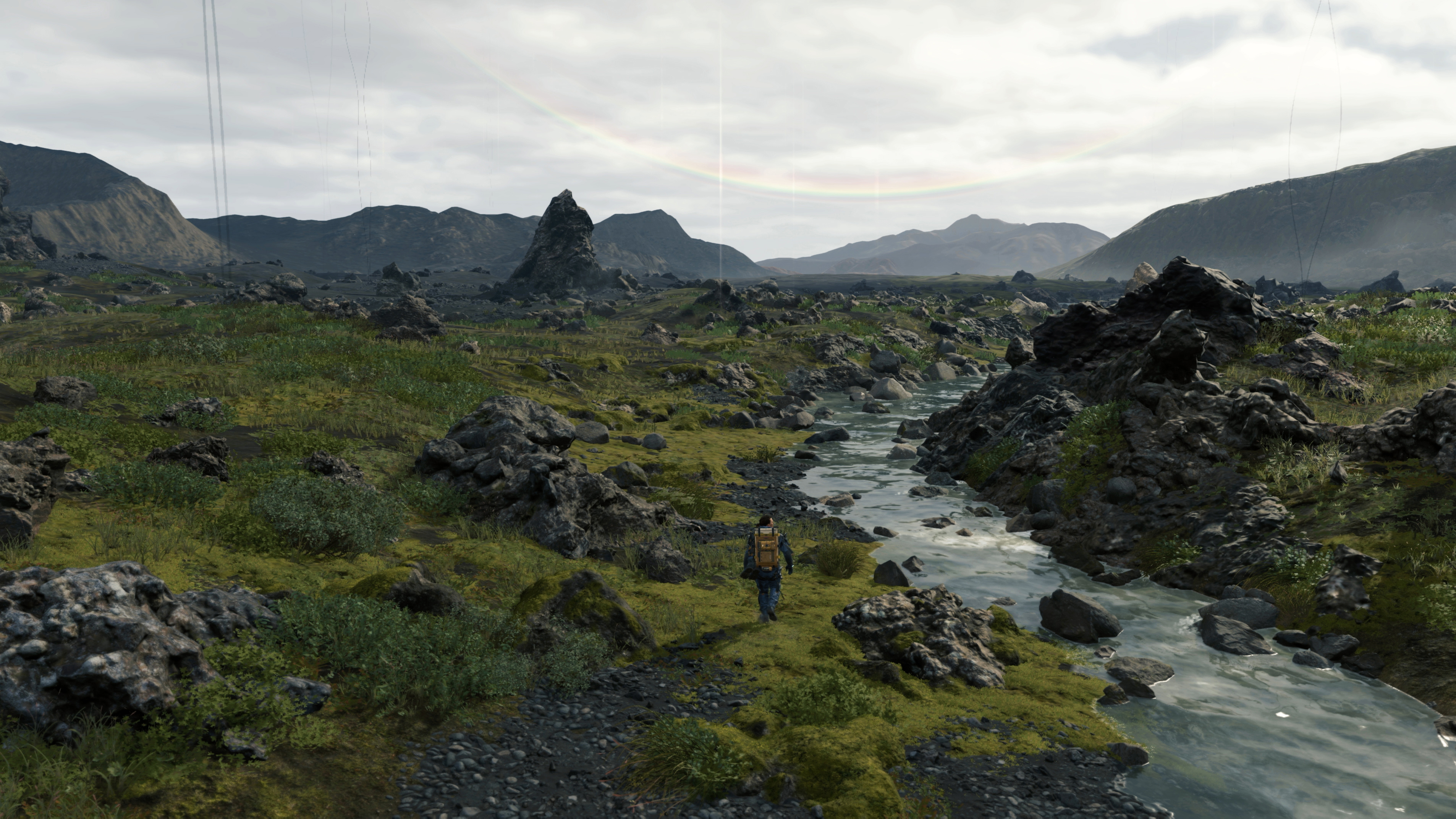
Death Stranding release date
There’s no definite release date just yet, despite Kojima having told fans during the 2016 Tokyo Game Show that Death Stranding would be out before 2019.
In an interview with Dengeki PlayStation (via Wccftech) at the end of 2017, Kojima said that development of the game was going well: “Development on Death Stranding is going well enough that [Sony Interactive Entertainment] told us, ‘We have never before seen a game being created at such a fast pace.’ We are planning an announcement that will further surprise everyone in 2018.”
A preemptive listing on Amazon UK put the release date as March 29, which came and went. A 2019 release still seems possible, though we've had no official confirmation of when to expect it.
In addition, Kojima revealed that the voice actor strikes in 2018 held up development as he was unable to record with Norman Reedus and Mads Mikkelsen during that period – delaying recording for the game.

What do we know so far about Death Stranding?
Death Stranding is in a 'critical phase', according to Kojima
Thanks to a tweet by Kojima, we now know the game has reached an important phase of development and is even capable of running on the PlayStation 4.
The following tweet by Kojima (roughly translated by MSPoweruser), explains that while Death Stranding is fairly far along in development, there's a lot of polishing to still be done.
"Death Stranding is not yet in the debugging stage, but is currently having all the game elements and tools from different development systems combined into the game," Kojima writes. "It’s a process that involves connecting the parts, adding feeling, looking over the production, the specifications, looking out for trouble, taking things out and adding things in.
"I’m playing the game on PlayStation 4 every day. It’s a critical phase."
Tribeca Film Festival
We learnt a few new tidbits at the Tribeca Film Festival, which hosted a panel discussion with Hideo Kojima and Norman Reedus. Much of it was about how immersed Reedus was with development, with his entire face and body (tattoos and all) having been scanned into the game.
“In Death Stranding I’m trying to put every aspect [of Norman] in there,” Kojima said through his interpreter, “and you will see his … everything, in the game,” he finished, suggestively, cracking up the crowd. By the end of the game, he says, you’ll “love Norman”.
Non-branching narrative
Kojima also stated there would be some painful choices to make in the game, though followed up by saying the player wouldn't really be able to influence the story through their decisions. Sounds like some different cutscenes or dialogue options, though not much in the way of affecting plot.
Online features
One of the biggest teases at Tribeca was the recurring mention of online features, though Kojima avoided talking directly about what this would look like in the game: "You're connecting the game, and everyone is playing it together, and you'll be connected, everyone will be connected together as well." Maybe a way to communicate or leave notes for other players, in the vein of Dark Souls?

Troy Baker is a villain
Veteran voice-actor Troy Baker (who voices Joel in The Last of Us series) stars in Death Stranding as the enigmatic antagonist The Man in the Golden Mask. Baker was introduced in a teaser trailer shown during Tokyo Game Show, with his skull-masked character summoning a black tar-like demon to take on Norman Reedus' character.
E3 2018
E3 brought a brand new trailer, few answers and even more questions. The trailer for the game had the most revealing description we've seen yet, stating the game is about Sam ‘Porter’ Bridges, a delivery man who must journey across a vast world so that he can “reunite the shattered world one step at a time.”
We also got look at two more famous faces who will make an appearance in the game – Léa Seydoux and Lindsay Wagner.
Something edgy Back in 2015 Kojima starting giving hints around the game's tone and star-studded voice cast in an interview with IGN. According to Kojima his first title with Sony is going to be “slightly more edgy”, as while he wants “to create something that’s what people expect” he also wants to bring “something new that people haven’t seen before.”
We do know that Kojima is planning to do something different with the game’s mechanics, most notably around the concept of dying and involving the baby that has appeared in every trailer. Kojima said in the interview that the mechanics of Death Stranding were inspired by a Japanese short story.

In the story it’s stated that the first tool mankind creates is a stick for protection, but that the second tool mankind created was a rope to keep things close and secure. “Most of your tools in action games are sticks,” Kojima explained, “You punch or you shoot or you kick. The communication is always through these 'sticks.' In [Death Stranding], I want people to be connected not through sticks, but through what would be the equivalent of ropes… But of course you will be able to use the sticks too.”
Unfortunately we haven’t seen any gameplay that would give us a better insight into how this rope approach will actually work.
A mystery to its own devs
At a Q and A session at the E3 Coliseum in 2017, Kojima himself said that his own team didn't understand the game: "I started explaining a year ago to the team what I wanted to make. No one got it!"
Before this, the game's star Mads Mikkelsen admitted he "got lost" when Kojima tried to explain the game's plot to him.
Sporadic details
Though Kojima has been coy, he’s given some nice teases into what we can expect from Death Stranding in terms of tone and gameplay modes.
We know the game will run on the Decima engine which was created by Horizon: Zero Dawn developers, Guerilla Games. Kojima praised this engine during PSX 2016 as being an excellent engine for creating open world games, something that Horizon: Zero Dawn’s reception suggests has an element of truth to it.
Though its unsettling trailers suggest otherwise, Kojima has said that Death Stranding won’t be as dark as some fans are expecting. It’s certainly not a horror game, he told Glixel, and it would have comedic moments which isn’t entirely surprising considering the overarching tone of the Metal Gear series.

An impressive cast
We already knew Death Stranding had some big names attached to it including Norman Reedus and Mads Mikkelsen . But now we know they'll be joined by writer and actress Emily O'Brien and the voice of video games, Troy Baker.
O'Brien recently posted a picture to Instagram which showed her alongside Baker and Reedus, with a caption stating "Honored to be working alongside these two fine lads on [Hideo Kojima's] new project Death Stranding."
While Baker is well known for his starring roles in video games such as The Last of Us and Bioshock Infinite, O'Brien has had roles on both TV and in games, featuring in Telltale's Guardian's of the Galaxy and Batman: The Enemy Within as well as Rock in a Hard Place.
Players won't die
In a recent interview with IGN, Hideo Kojima was slightly more open with details than he usually is. The strange underwater sequence from the 2017 Game Awards trailer for example? That's apparently a kind of purgatory where players will go and freely explore when they die in the game, though Kojima notes that "death will never pull you out of the game."
The game apparently explores the themes of life and death and it's for this reason that Kojima would like to explore the traditional death mechanic in games and let players know that in-game death isn't the end for them when it happens.
In this underwater area, he explains, “you're not dead or alive. It's the equivalent of that screen that says 'Continue?' and a counter ticking down towards zero.” When players decide they're ready to leave and return to the game world, they won't be returned to a point before their death. Instead the game acknowledges their defeat and coming back to life is more of a reincarnation than a respawn.
There's a weird time rain
During the trailer shown at the 2017 Game Awards, fans noticed there's a strange kind of rain that has an effect on time. In makes plants grow and wilt and makes human bodies age and degenerate when it touches them. The rain is apparently called Timefall and it has a big role to play in the game's story.
What's the deal with the babies?
There's been some seriously strange recurring baby imagery in the footage we've seen for Death Stranding that's included Norman Reedus cradling a baby while standing nude on a beach as well as having one living inside his throat. According to Kojima in an interview with IGN, the baby is apparently the same baby and it's a part of the game mechanics as well as the overarching plot. We assume it's related to the idea of not ever finitely dying but Kojima didn't confirm this.
There will be online elements
We already knew there would be online co-op elements in the game after Kojima confirmed it at the Tokyo Game Show, but in a recent IGN interview he acknowledged that he's been keeping up with recent players reactions to things like microtransactions.
“I think there are a lot of people out there who still enjoy single-player games, aside from some microtransactions." This suggests that while the game will have online co-op elements, they won't make up the entirety of the game.
What could it all mean?
Though the game’s trailers don’t tell us much about how we’ll eventually play Death Stranding, they do reveal some important thematic elements.
Quotes from William Blake, the repeated appearance of ruined dolls, and the inclusion of what looks like oil (but could very well be ink) and dead sea creatures suggests Kojima will be exploring the fractious relationship between man and the natural world and the impact it has on us and future generations.
The littering of dead crabs on beaches and tanks with definitely living tentacles coming out of them suggests to us a post-apocalyptic world over-run with robotic sea creatures which would certainly be interesting. After all, Kojima is working closely with Guerilla Games whose Horizon: Zero Dawn game focused on robotic dinosaurs.

There’s also a curious mix of futuristic technology and elements of the past in the game’s various trailers.
In the second game trailer though Mads Mikkelsen is wearing a modern army uniform and appears to be using some kind of cable, the undead soldiers around him are wearing WW2 era uniforms and the game world outside of the tunnel he’s in is almost certainly from the second world war time period.

Whether this mix of past and future will manifest itself as time travelling or simply alternate universe science fiction isn’t clear.
Safe to say, as a Kojima title, there’s a lot of mystery and symbolism at play here and fans online are tearing through what little materials there are to try and find out more information about the game.
We’ll keep updating as more solid information becomes available.
All image credits: Kojima Productions
from TechRadar - All the latest technology news http://bit.ly/2pVkQmm
via IFTTT
The best Nokia 8 deals in May 2019
2017 marked Nokia's renaissance year. After stunning us by announcing it was revamping the Nokia 3310 and then releasing a further three mobiles, it ended the year by releasing its first high-powered smartphone in three years - the Nokia 8.
Almost two years on and although it's never going to challenge the power of Samsung and Apples newer devices, it does have the kind of price tag that will appeal to people who want to get a bargain mobile phone. Especially excellent value, considering the stunning design, premium screen and chipset, and new 'Bothie' camera mode.
Unlike most flagship phones released in the last 12 months, you can now get your new Nokia 8 for less than £20 per month! Check out our comparison tool to see the best tariffs that have been announced. Considering the standalone handset costs around £400, the contract prices are looking like a much better option.
See more: Nokia 3310 deals | Nokia 3 deals | Nokia 5 deals | Nokia 6 deals | Best mobile phone deals

It's been a while, but Nokia is finally back with a serious phone. Of course we were all delighted to see the return of the Nokia 3310 through a nostalgic haze, but if Nokia was going to be regarded as a genuine threat to the likes of Samsung, Apple and LG again, it needed a handset of heft.
The Nokia 8 is exactly that. Not in its dimensions, mind you - weighing in it at 160g, it's a slim, sleek and sometimes shiny smartphone. We're referring more to the dazzling QHD 5.3-inch display, 4GB Ram and Snapdragon 835 chipset. All massive plus points in our eyes, even if the much touted 'Bothie' camera mode probably isn't.
Read TechRadar's full Nokia 8 review
from TechRadar - All the latest technology news http://bit.ly/2iKZYid
via IFTTT
Future smartphones could be made of this material to keep cool
When you buy a smartphone it'll likely have a plastic, glass or metal body, but in the future you might not get these options – instead, your handset could be made of a new custom polymer.
Researchers at MIT recently unveiled a new polymer material, after several years working on it, that could have a big impact on what future smartphones, and other tech products, are made of.
- What new features will the iPhone 11 bring to the table?
- This is what we know about the OnePlus 7
- This is what we want to see in the Samsung Galaxy Note 10
The most important feature in the custom polymer is that instead of containing heat, like the back of your smartphone will do when the device heats up, the material will conduct it much more efficiently. This means a phone will be able to cool much easier, and won't heat up as much when used intensively.
On top of that the researchers have spent a long time working on an efficient and cheap manufacturing process. The material would be a lot cheaper to produce than the glass and metal of premium phones, and manufacturers could reduce costs by embracing it.
The material is also significantly thinner than your typical handset case, so future phones could be a little thinner – but they could also be a little more delicate too, depending on how strong the polymer is.
At the moment the custom polymer isn't ready for commercial use, so even if manufacturers do choose to use it in their phones (which there's no guarantee of), it'll be a while until we see phones made up of it.
Via Trusted Reviews
from TechRadar - All the latest technology news http://bit.ly/2PCbxVM
via IFTTT
The best HTC U11 deals in May 2019
The HTC U11 had the hard task of attracting consumers' attention away from the vice-like grip on the phones market of the Samsung Galaxy S8 and iPhone 8. But HTC managed to create a device that rivalled those devices when they were released. A year has passed now and yet this phone is still a serious contender in the mobile phone market.
The HTC U11 (don't forget that all important 'U') is another push from the manufacturer to keep its name as a front-running handset manufacturer. Edge Sense is the new element that the brand is pushing as its latest big innovation - as you'll see from our HTC U11 review below - it's certainly alternative. And the phone now comes with Alexa integration, too.
It's now a little cheaper, too, with monthly tariffs starting at less than £30. That's a lot cheaper than HTC U11 deals were when the handset went on sale. Check out our comparison chart to tailor-make your perfect HTC U11 deal.
See also: Samsung Galaxy S8 deals | iPhone 8 deals | Galaxy Note 8 deals | Best mobile phone deals | HTC U11 review

The HTC U11 is a hugely impressive phone - in a sea of wildly impressive phones. The core abilities will wow any HTC fan, but the squeezable sides haven't completely won us over.
Read our full HTC U11 review here.
from TechRadar - All the latest technology news http://bit.ly/2rlE6sZ
via IFTTT
The best Google Pixel 2 and Pixel 2 XL deals in May 2019
The Google Pixel 2, the 2017 apple of the search giant's smartphone eye, is almost at an end. The Pixel 2 may soon be dead, but long live the Pixel - the Google Pixel 3 has been here for a little while now and has replaced it entirely.
If you've been fancying the Pixel 2 for a while and really don't want to splash the cash on the much costlier new phone, then you'll have to strike pretty swiftly as we're not sure how much longer this device will stay relevant. And the same goes for the Google Pixel 2 XL.
Whichever handset you covet, you can use our price comparison below to identify the best Pixel 2 deal for you. Google's quest to build a smartphone as popular as the latest iPhone and Samsung Galaxy flagship mobiles took a massive step forward when the original Google Pixel launched last year. And its successor - the aptly named Google Pixel 2 - continued the stellar work and now the Google Pixel 3 has stepped that up even further.
Need some more convincing? Use the 10OFF voucher code from Mobiles.co.uk that knocks a tenner off the upfront cost of any deal from that retailer - it's exclusive to TechRadar readers. And there's a summary of our expert review at the bottom of the page.
More options: Samsung Galaxy S9 deals | Samsung Galaxy Note 9 deals | iPhone 8 deals | SIM only deals | Best mobile phone deals

There's no doubt that the Pixel 2 was one of the very finest Android phones out there on release (and, to be fair, remains so), but the Pixel's successor is a familiar story of incremental improvements rather than whole-scale change. The feature that might just get you buying are the top-of the-line cameras for photos and video. While the delightful screen, great-sounding speakers and slick Android operating system will all appeal to a range of smartphone users.
Read TechRadar's full Google Pixel 2 review
Read TechRadar's full Google Pixel 2 XL review
from TechRadar - All the latest technology news http://bit.ly/2kn5dp0
via IFTTT
The best BlackBerry KEYone deals and prices in May 2019
Fans of the old Blackberry devices rejoice because the physical keyboard is back - what a comeback story. The BlackBerry KEYone landed on the phone scene almost two years ago and (whisper it quietly) it's still actually rather good.
We've been keeping a keen eye on the best Blackberry bargains out there, and the prices continue to slowly fall. Unlike when it was released, you can now get the KEYone on contract for way less than £20 per month - and now even under the £20-mark! And you don't have to scrimp on data either. Check out our price comparison tool and you'll see that these BlackBerry deals compare handsomely with some of the other best mobile phone deals out there.
Equipped with an updated version of that keyboard, Full HD screen and 12MP main camera, the Blackberry KEYone runs off Android. It may not quite be a match for the likes of the Samsung Galaxy Note 9, but it's not far off and it's way cheaper.
More options: Samsung Galaxy S9 deals | LG V30 deals | Best iPhone deals | Best SIM only deals | Mobile phone deals

The BlackBerry KEYOne is the smartphone for anyone who has ever said ‘I miss my old BlackBerry.’ We can't fault it for admirably resurrecting the best of BlackBerry: a physical keyboard, sophisticated-looking, two-tone design and smart, secure software. It looks and feels like it’s meant for business.
Exiled BlackBerry users who have felt forced to trade their physical keyboards for on-screen keyboards will undoubtedly rejoice.
Read TechRadar's full BlackBerry KEYone review
from TechRadar - All the latest technology news http://bit.ly/2qn7uTv
via IFTTT
The best Samsung Galaxy S7 deals in May 2019
The Samsung Galaxy S7 may now be over two years old but it is by no means a bad device. In fact, the Samsung Galaxy S7 is a great handset for bargain hunters. You've probably seen the insanely-great Samsung Galaxy S9 or Note 9 or even Samsung's newest Galaxy S10, but then also seen the prices and decided to see what else is on offer. Bag a Galaxy S7 deal and you'll get a fantastic phone for a reasonable price.
2016's Galaxy S7 - together with the bigger S7 Edge - is still a very good handset in its own right, sharing a lot of the battery management power and camera smarts from its successor the Galaxy S8. You can see a potted review under our top handpicked deals below and it's soooooo much cheaper than the newer Samsung smartphones.
You can easily get away with bills in the low twenties. Or, if you're prepared to part with around £50 at the outset, you can even get them below the £20 mark. And big data deals now come cheap, too. Excellent value when you consider that the S7 used to be one of the best phones around. You will notice though that the majority of deals still going for this device are on EE, it seems to have knocked all other competing networks off the list.
Also consider: Galaxy S7 Edge deals | Galaxy S9 deals | Galaxy S8 deals | Galaxy Note 8 deals | iPhone deals | Best SIM only deals | Galaxy S7 review

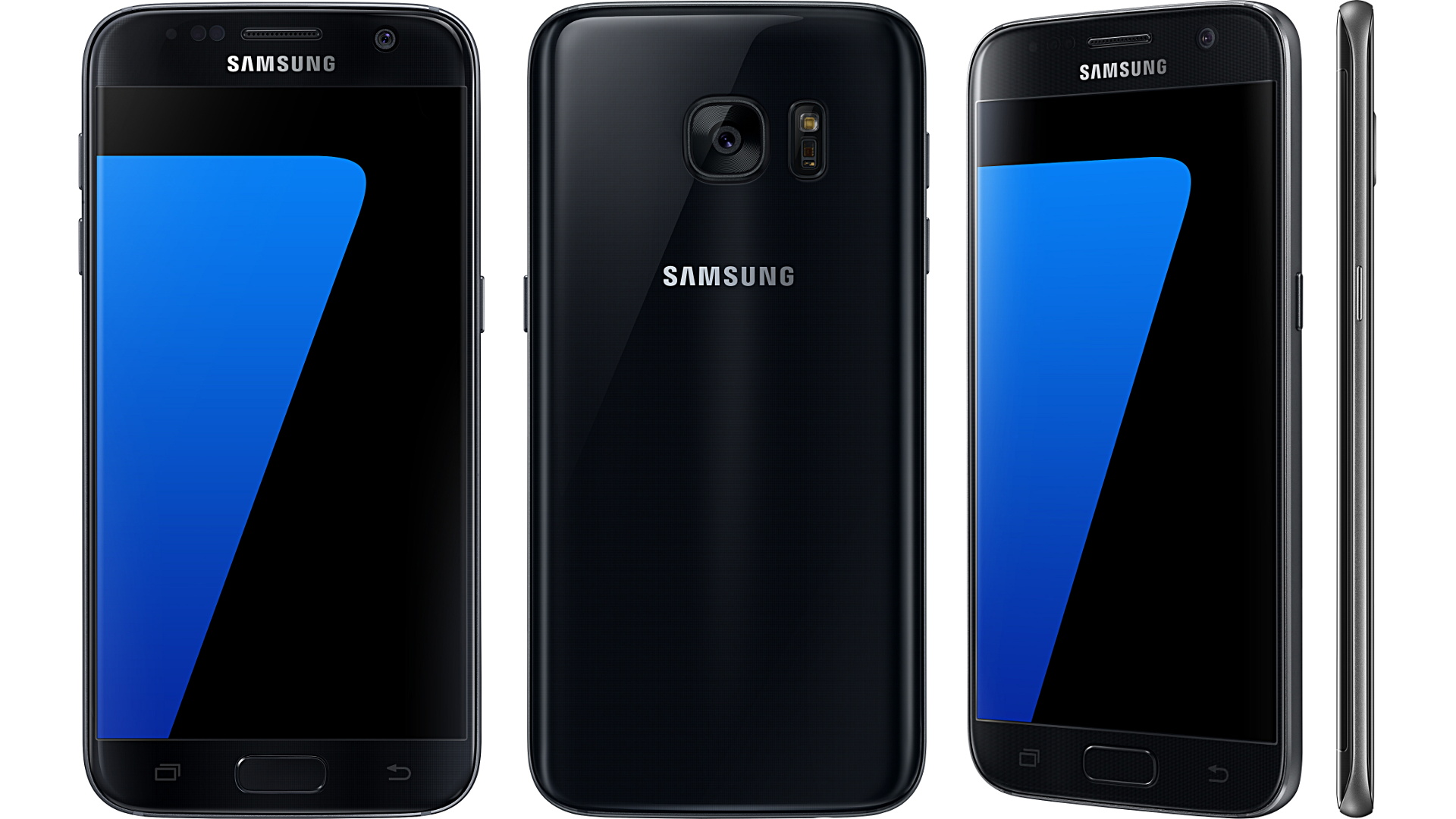
- Check out all of the best Samsung mobile phone deals
The Galaxy S6 definitely left some room for improvement and, thankfully, Samsung tinkered and tweaked the design to make one heck of a successor. The Galaxy S7 is iterative perfection - it doesn't reinvent the wheel, but Samsung clearly listened to the feedback and criticism to create a stand-out device.
Read TechRadar's full Samsung Galaxy S7 review
from TechRadar - All the latest technology news http://bit.ly/1Qby8E5
via IFTTT
The best Nokia 3310 deals and prices in May 2019
The reboot of the iconic Nokia 3310 phone has generated a lot of buzz since it was sensationally revealed in 2017. Do not underestimate the nostalgia for the simpler, cheaper mobile phones - or for Snake!
A growing number of retailers - including Amazon and Argos - sell the Nokia 3310, and we can tell you who has it cheapest below. And it's now finally available on contract, too, although we think it makes far more sense just to buy the handset and grab a separate SIM only deal.
If you decide that you want something a bit more advanced than the Nokia 3310, then try our selection of the best SIM-free phones and deals or check out the Nokia 3 and Nokia 5.
The 2017 Nokia 3310 is looking like a great purchase for anyone looking for a spare mobile to take camping, or to festivals, thanks to its super-low cost and long life between battery charges. Maybe you just don't need all the bells and whistles of a modern smartphone, or perhaps just want to bag a cheap mobile phone deal.
Where can I buy the new Nokia 3310 SIM-free?
Vodafone was the first big network to start stocking the new Nokia 3310, before other major retailers - such as Amazon, Argos and Tesco Direct - turned up to the 90s themed party. If you've got fifty pounds on you, you can get hold of a Nokia 3310 and still get change in return.
Once you've picked out the handset you want to buy, you can then head to our SIM only deals page to buy a cheap SIM to pop in it with prices starting from well less than a fiver per month.

Best Nokia 3310 deals on contract
We waited aaaaaaaages after the Nokia 3310's release to see some contract plans, and now it feels like we shouldn't have bothered. Although we've seen tariffs for as little as a tenner a month with nothing to pay upfront, we can't imagine why you'd bother committing yourself to a lengthy contract, when you can just buy the handset cheap as chips and get a more flexible SIM or pay-as-you go price.
Is the Nokia 3310 any good?
A new Nokia 3310 was always going to make misty-eyed a generation whose youth was spent whiling away hours on Snake. But there's more to this phone than purely nostalgia. Its featherweight design, convenient number keys, marathon battery and ridiculous price is going to appeal to people who just want a very cheap handset for festivals, holidays and emergencies. And did we mention Snake?
For those people who expect their smartphones to be kitted out with high resolution displays and industry leading cameras, clearly the Nokia 3310 is the polar opposite. Read more about the pros and cons in our full Nokia 3310 review.
What colours are available for the new Nokia 3310?
The new Nokia 3310 is available in a range of colours. Depending on where you buy it from, there are options in blue, black, red, yellow and grey.
from TechRadar - All the latest technology news http://bit.ly/2mLMq7g
via IFTTT
The best Samsung Galaxy Watch Active prices and deals in April 2019
Along with the announcement of the Galaxy S10 phone, Samsung also unveiled its newest Galaxy smartwatch, the Samsung Galaxy Watch Active. The latest Samsung wearable is available for purchase now, so we've rounded up the best Samsung Galaxy watch prices and deals for from several retailers below.
As the name implies, the Samsung Galaxy Watch Active is focused on fitness, and its new design and features reflect that. The ultra-lightweight Galaxy Active comes in one size and features a 1.1-inch display. The fitness watch continually monitors your heart and will send alerts when an abnormal heart rate is detected. The Samsung watch can also help with your sleep and stress, analyzing your sleep patterns and sending you breathing exercises when high stress levels are detected. The Galaxy Active will also help you keep on track with your health and fitness goals by tracking up to 39 exercises and displaying your health summary on the smartwatch display. The waterproof watch comes in four different colors and has a battery that lasts for days on a single charge.

Samsung Galaxy Watch prices
The Samsung Galaxy Active Watch currently retails for $199.99/£229. The main reason the Active Watch is cheaper than the original Samsung Galaxy Watch ($329 / £279 for the 42mm model) is that the Active is missing the rotatable bezel, a core feature from the Samsung Galaxy Watch. So navigation of the menus and features is handled by the touchscreen and two side buttons. If you plan on using the Samsung watch just for fitness purposes, then the Galaxy Active is a great alternative at a lower price. You'll find all of the prices from several retailers below.
You can also find out more about the Samsung smartwatch with our Samsung Galaxy Watch Active review.
If you're interested in Samsung's newest phone you can find the best Samsung Galaxy S10 prices and deals in the US, and we've got you covered for UK pre-order deals of the Galaxy S10 too.
from TechRadar - All the latest technology news http://bit.ly/2KphczB
via IFTTT
The best iPad games of 2019
The iPhone revolutionized gaming through multitouch, but the iPad provided a larger canvas and power for fully immersive and expansive experiences.
Apple’s tablet remains a powerful, engaging gaming device, whether you delve into innovative touchscreen games, or use a controller for a more console-style experience.
Whatever you prefer, the very best games are found in our lists. Check back weekly for our latest favorite.
iPad game of the week: Typoman Mobile (free + $1.99/£1.99/AU$2.99)

Typoman Mobile is a platform puzzler with a twist – much of its world is made of letters. That even includes the protagonist, who begins life as a trundling letter O, before subsequently acquiring a body (E) and some limbs.
The silhouette visuals echo Limbo, as do aspects of the controls and gameplay. However, the game is keen to use language as a key to unlock solutions. You may find yourself fashioning the word ‘rain’ to fill a lake, or shoving an O into an N to activate a platform.
The controls are a touch awkward on the iPad, and occasionally hasten failure. But the game lets you try each challenge an endless number of times, and outside of a few frustrating moments is relentlessly captivating.
Our favorite iPad immersive adventures, point-and-click games, and story-led narratives.
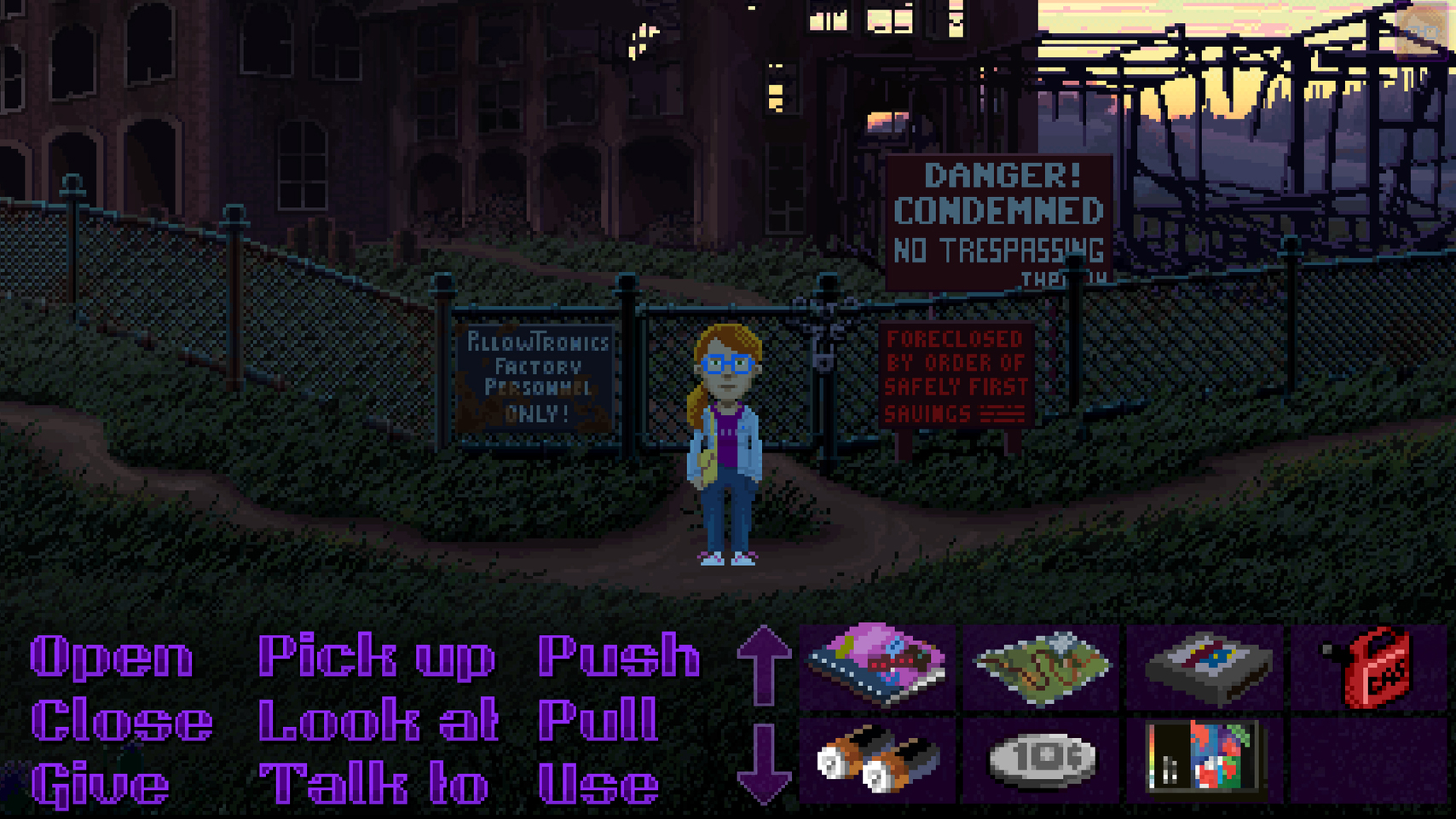
Thimbleweed Park ($9.99/£9.99/AU$14.99)
Thimbleweed Park is a love letter to classic point-and-click adventures, designed by two of the industry’s most devious minds. Ron Gilbert and Gary Winnick were the brains behind classics Maniac Mansion and Monkey Island, and Thimbleweed Park is no less tricksy as you ostensibly attempt to solve a murder mystery.
We say ‘ostensibly’ because the dead body you quickly find is the least of your problems. Over the game’s length, you end up playing several characters, including feds, an aspiring game developer and a vulgar, down-on-his-luck clown.
The interface is a bit of a 1980s throwback, as is the difficulty level. Thimbleweed Park can be absurdly obtuse, and a little awkward. But there are few iPad adventures that match this one’s humor, heart and cunning – and no others that feature plumbers who happen to be paranormal investigators who dress as pigeons.

Subsurface Circular ($4.99/£4.99/AU$7.99)
Subsurface Circular exists in a gray area between novella, short film and videogame. Set in a single carriage within an automated transit system, it features a cast of Teks – androids that have replaced humans in many of society’s roles.
You play a detective Tek, which spends its life interrogating other robots on the Subsurface Circular, and are immediately embroiled in a mystery. To say more would spoil things, so take it from us that the story entrances, twists and turns over its few hours.
Despite the single-scene setup, the game looks superb, with a cast of varied Teks and a familiar messaging-style interface that has a distinctly futuristic sheen. And if you’re concerned about the game’s brevity, be mindful you’d spend as much renting a film, and probably wouldn’t have nearly as much fun.

Adventures of Poco Eco – Lost Sounds ($3.99/£3.99/AU$5.99)
Adventures of Poco Eco – Lost Sounds is as much an exploratory experience as a game. The hero discovers a ‘lost cassette’, which enables him to speak with spirit guides. They charge him with a musical quest: to bring sounds back to the land.
That might sound pretentious and ‘worthy’, but Poco Eco is more like a cartoon. One of your early guides is a massive bear, and Poco Eco jauntily scoots about the larger-than-life landscapes packed full of color and giant musical kit, bobbing his head to a soundtrack that evolves as puzzles are solved.
Said puzzles are, admittedly, dead simple. Poco Eco isn’t a game to fire up if you want your brain smashed in with a stiff challenge. It is, however, perfect for when you want to relax and immerse yourself in an album reimagined as an explorable world.
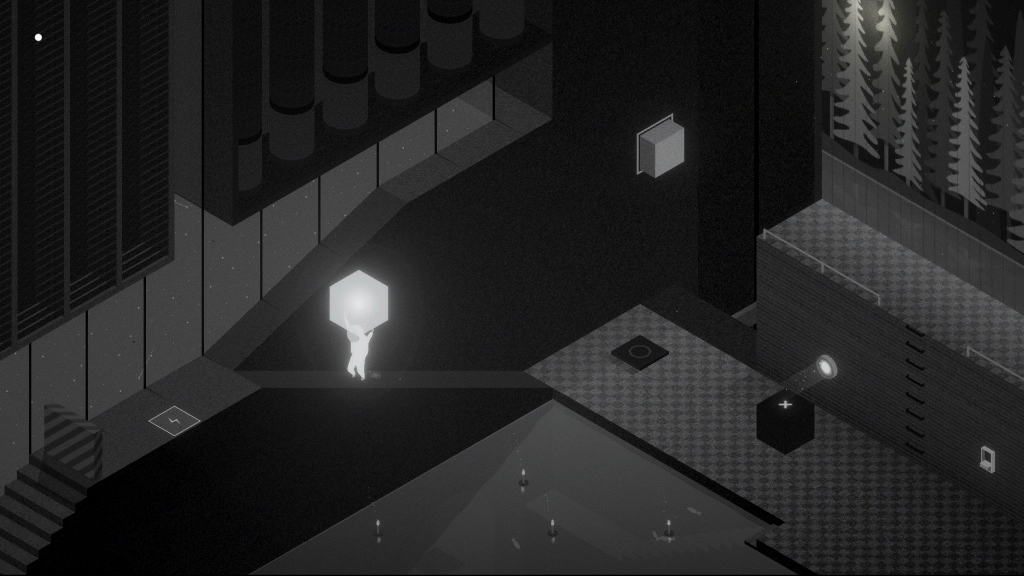
Starman ($3.99/£3.99/AU$5.99)
Starman is an atmospheric adventure featuring a little astronaut trying to bring light to a monochromatic world. Its composed, unassuming air at times echoes Monument Valley. But the puzzles and slow, considered movement recall classic 1980s isometric puzzlers like Head Over Heels.
Regardless of its influences, Starman is a treat. Every puzzle you try offers something new – and some of them are really clever. The mechanics are never complex, but how they’re combined will often trip you up. Yet Starman is never unfair – when you hit upon a solution, it will seem so obvious.
The only real downside is there’s a chance the slothful pace will put off some players. It can be tiresome in some puzzles to watch the astronaut trudge back and forth. But for players who aren’t in a tearing hurry to blaze through every game, Starman’s a reflective, smart, memorable experience.

Flower ($4.99/£4.99/AU$7.99)
Flower is a game that revels in bombing along as a petal on the wind, scything your way through fields of lush grassland, and soaring into the air above mountains and windmills.
Each environment starts with you playing as an individual petal. As you collide with other flowers, they bloom and offer a petal of their own to join yours, which soon becomes a spinning, swooping conga of color, wheeling above Flower’s tiny, beautiful worlds.
There’s a smattering of exploration and light puzzling in Flower, primarily to unlock more parts of each level, and discover secrets. But mostly this game is about enjoying an immediate, accessible, beautiful journey that has an emotional core and an exhilarating edge.
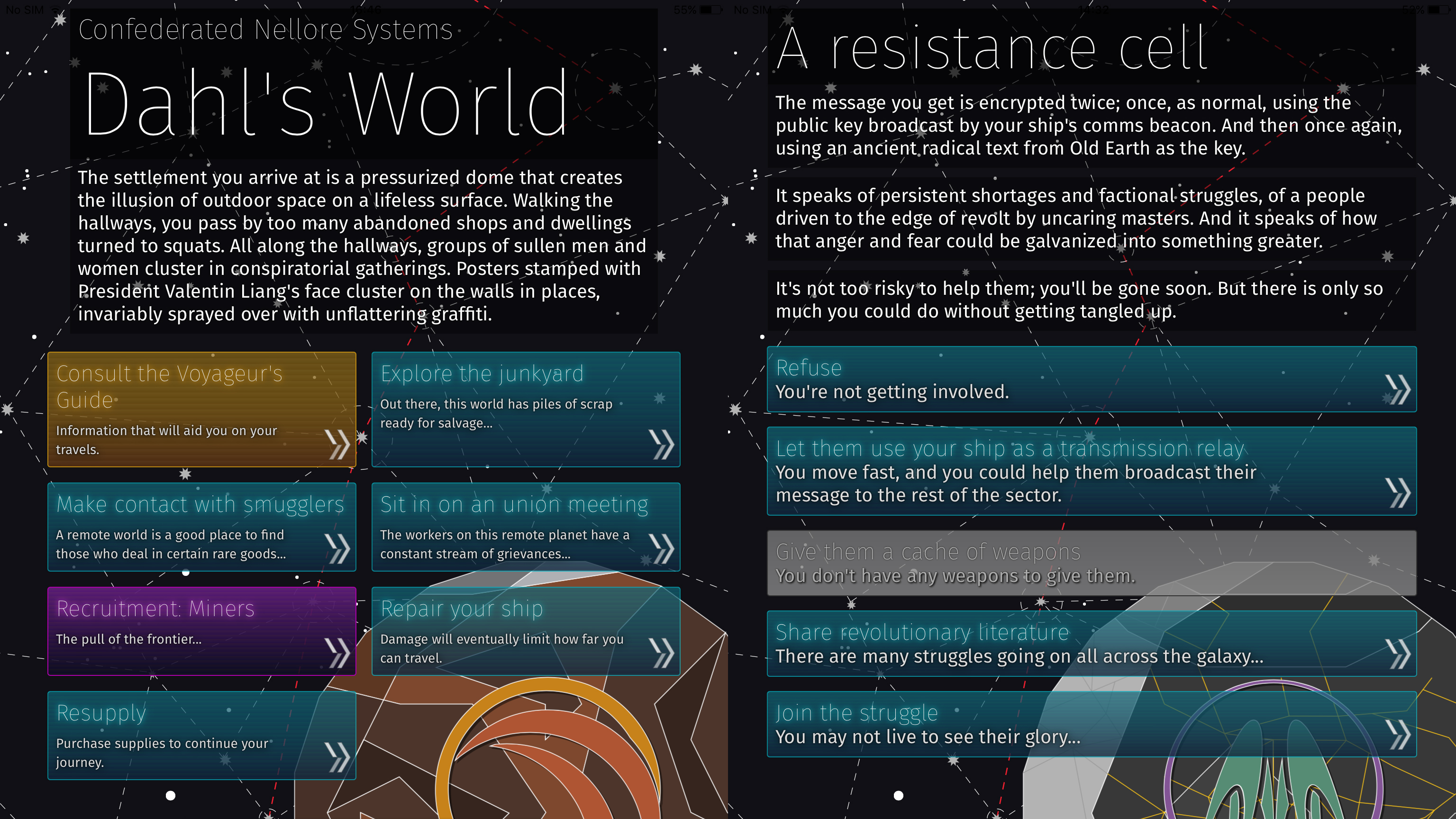
Voyageur ($3.99/£3.99/AU$5.99)
Described by its creator as a literary RPG, Voyageur mixes text adventure with space trading. Imagine seminal classic Elite combined with Lifeline and you’re on the right track.
The story begins with you having bolted an alien ‘Descent Device’ to your ship, enabling faster-than-light travel – but only towards the center of the galaxy. You embark on a one-way journey, stopping off on planets to trade, explore, and become embroiled in side quests.
With the game being text-oriented and algorithmically generated, descriptions and events tend to repeat quite often. Still, if you at any point feel you’ve seen a planet before, you can leave with a few taps – and there are always new things waiting to be found. For anyone armed with an imagination, Voyageur becomes a unique, captivating experience.

Milkmaid of the Milky Way ($3.99/£3.99/AU$5.99)
This old-school adventure game is all the more impressive when you realize it’s the work of one man. From the delicate pixel art to the smart story – all delivered in rhyme – you’d think a team of clever people had beavered away on Milkmaid of the Milky Way rather than a sole individual.
The star of the show is Ruth. Her tools have vanished in a storm, and she needs to make cheese and butter to sell. It’s all very slow and relaxing – until a spaceship abruptly shows up and rudely steals her cows, propelling her into a rather more out-of-this-world experience.
If you’ve played this kind of game before, you’ll know what to expect – explore your surroundings, find objects, and figure out where to use them.
But the difficulty curve is gentle enough to snare newcomers, while the feel and polish of the game should help it appeal to anyone who spent years taking on Lucasfilm fare on a PC.

Samorost 3 ($2.99/£2.99/AU$4.49)
From the creators of Machinarium and Botanicula, Samorost 3 is an eye-dazzlingly gorgeous old-school point-and-tap puzzler.
It follows the adventures of a gnome who sets out to search the cosmos and defeat a deranged monk who's smashed up a load of planets by attacking them with a steampunk hydra.
The wordless tale primarily involves poking about the landscape, revealing snatches of audio that transform into dreamlike animations hinting at what you should do next.
Although occasionally opaque, the puzzles are frequently clever, and the game revels in the joy of exploration and play. It's also full of heart – a rare enchanting title that gives your soul a little lift.

Love You to Bits ($3.99/£3.99/AU$5.99)
Love You to Bits has a heart as big as a thousand iPads. It's a tap-based adventure that finds a little space explorer trying to retrieve pieces of his android girlfriend that have been scattered across the galaxy.
The mechanics are right out of classic point-and-click gaming, essentially having you amble about 2D locations, unearth items and then drop them in the right spot.
But the game is so relentlessly creative and inventive with its environments — full of dazzling visuals, references to movies and other games, and increasingly clever mechanics and ideas — that you can't help but love it to bits yourself.

Device 6 ($3.99/£3.99/AU$5.99)
Device 6 is first and foremost a story — a mystery into which protagonist Anna finds herself propelled. She awakes on an island, but where is she? How did she get there? Why can't she remember anything? The game fuses literature with adventuring, the very words forming corridors you travel along, integrated puzzles being dotted about for you to investigate.
It's a truly inspiring experience, an imaginative, ambitious and brilliantly realised creation that showcases how iOS can be the home for something unique and wonderful. It's also extremely tough at times. Our advice: pay attention, jot down notes, and mull away from the screen if you get stuck.
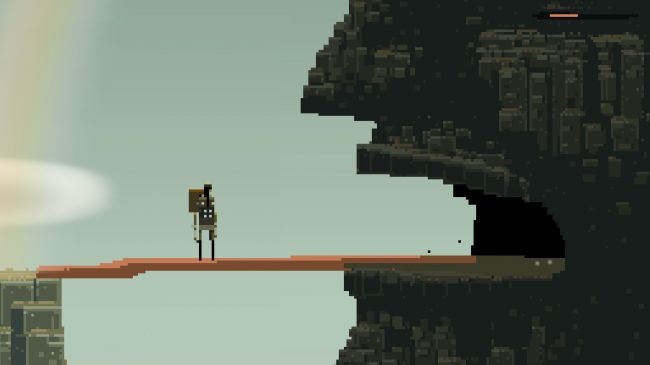
Superbrothers: Sword and Sworcery EP ($3.99/£3.99/AU$5.99)
Superbrothers: Sword and Sworcery EP has in its DNA the essence of point-and-click classics, and is infused with a substantial sense of adventure. It’s a game that very much wants you to explore and interact with its mysterious and atmospheric world. It also happens to be a concept album.
That might sound weird, but you soon find your time within this game’s world is anything but usual. The delicate pixel art has many surprises and strangeness buried within, and the evocative soundtrack is a high point on the platform.
The storytelling is sparse and smart (if sometimes too knowing), and combat is rhythmic (if a touch clunky). In all, the mixture of music, occasional swordplay, and exploration is not to be missed.
Our favorite iPad arcade titles, including retro games, pinball, slice ’em ups, multiplayer party games, and innovative touchscreen creations.

Microbian (free + $1.99/£1.99/AU$2.99)
Microbian is an atmospheric auto-runner, featuring a spider darting through creepy underground caverns. Your aim is simply to survive, which requires not being horribly killed by the many hazards on your path. You can tap to jump, and tap in mid-flight to switch to the ceiling or back to the floor.
Right from the off, the arachnid’s journey is quite tricky, placing your tapping digit under severe duress. The screen whirls around, ravenous creatures suddenly give chase, and you may find yourself abruptly hurled into the air by something springy.
It’s worth persevering though, because you soon get a rhythm for the game. At that point, you can improve your gaming prowess, but also get a chance to more fully breathe in Microbian’s gorgeous, moody visuals.
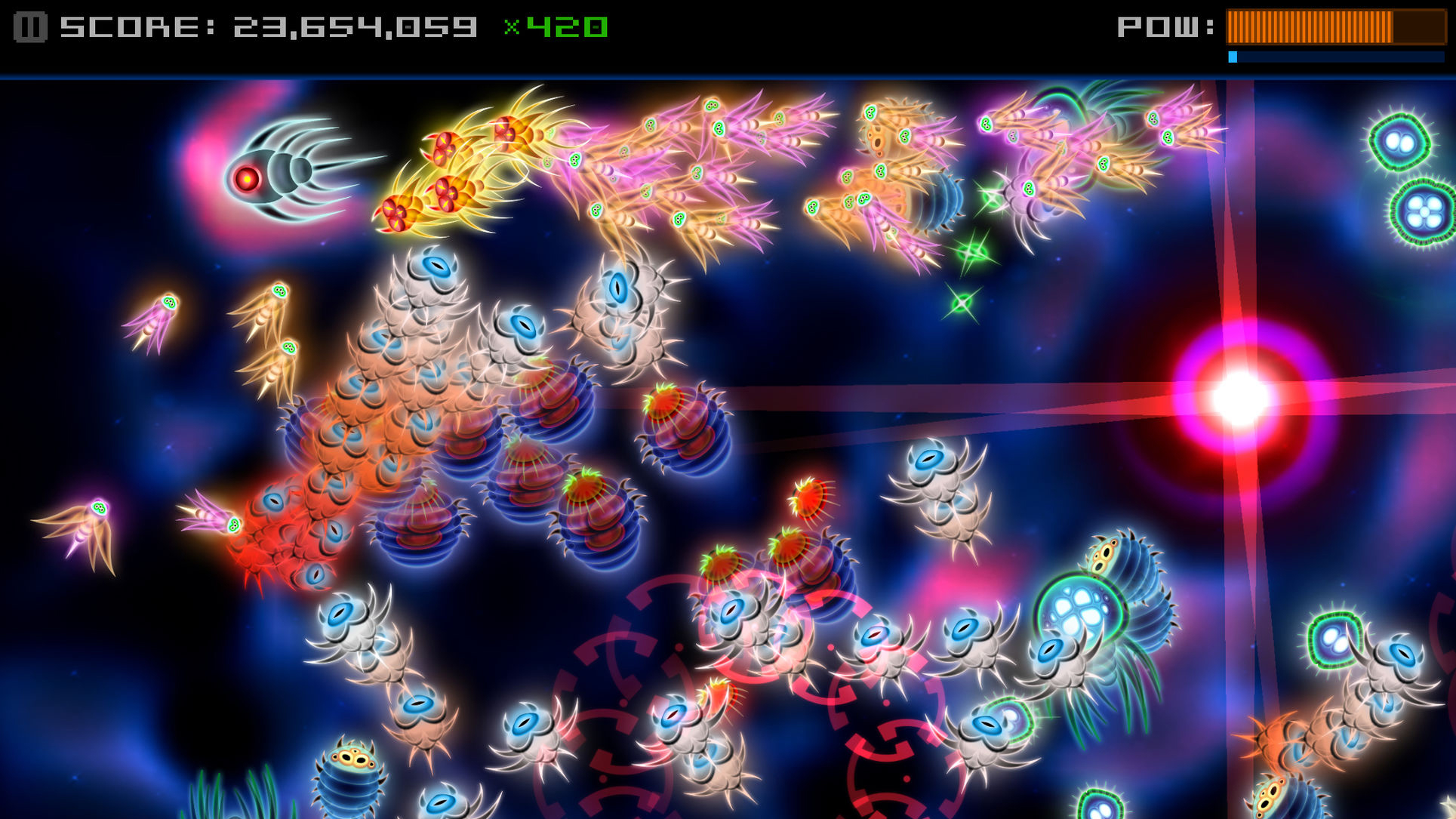
Silverfish DX ($3.99/£3.99/AU$5.99)
Silverfish DX is an unashamedly old-school arcade romp, albeit one with shiny modern visuals. You take the role of the titular silverfish, which finds itself surrounded by aquatic and very hungry enemies.
To survive, you must weave your way through the swarms, grabbing power pods that obliterate anything nearby. Max out your power – depleted during collisions – and you can briefly turn the tables on your foes by eating them.
This is a mix of Robotron’s claustrophobia (but without the shooty bits) and those moments in Pac-Man where you get to eat the ghosts. Like those titles, Silverfish DX is perhaps a bit one-note, and so won’t keep you glued for hours at a time, but the game’s purity and compelling, exciting gameplay ensures it’s always worth a quick dip.

Helix ($2.99/£2.99/AU$4.49)
Helix has the appearance of a rough-and-ready 1980s arcade game. Your character, a chunky blinking eye, scoots about as adversaries rapidly appear from screen edges. The aim is survival, but fortunately you can do more than dodge (albeit less than shoot).
Move around an enemy and a line begins to encircle them. If the line is closed, the enemy explodes, giving you some breathing space. Some enemies require more orbits, or for you to encircle them in a specific direction, and that’s about it.
But Helix’s simplicity isn’t to its detriment. This is a focused, brilliantly conceived arcade blast that’s ideal fodder for iPad. The touchscreen controls are responsive, the lurid visuals are captivating, and the hard-as-nails gameplay has that one-more-go factor that will have you clamoring for more.

Trick Shot 2 ($2.99/£2.99/AU$4.49)
Trick Shot 2 at its core is a game that has you lob a ball into a box. At first, despite its ultra-chic minimalist visuals, it all seems a bit simple – even dull. But this game’s charms win you over rapidly.
In part, this happens as the levels become increasingly ridiculous. You end up bouncing the ball off of giant bananas, or figuring out how to get it into one box within a sea of the things – all, of course, positioned at awkward angles.
Each time you think you’ve cracked it, something new arrives to test your lobbing abilities: levers; teleporters; power connectors. And even when you emerge victorious from the final challenge, that’s not the end of it, since Trick Shot 2 has its own built-in level editor.

Alto’s Odyssey ($4.99/£4.99/AU$7.99)
Alto’s Odyssey is a one-thumb side-on endless survival game. It features the titular Alto, who has a thing for sandboarding on huge dunes, hurling himself into the air, performing all manner of tricks, and then trying to not land (i.e. crash) in a manner that results in a face full of sand.
This is perfect iPhone fodder, and perhaps not the kind of game you’d usually associate with iPad. But like its predecessor – the similarly impressive Alto’s Adventure – Alto’s Odyssey is a gorgeous game that’s deeper than it first appears.
Visually, it’s a treat, with arresting weather effects and day/night cycles. As you complete challenges, you slowly unlock new goals, environments, and abilities, but if at any point it all feels too much, you can switch off with the zero-risk Zen Mode, which leaves you with a serene soundtrack and endless desert.

FROST ($4.99/£4.99/AU$7.99)
FROST is a thoughtful, tactile game that feels like a living piece of art. Across dozens of scenes, sparks and barriers scythe across the screen while you direct flocking neon creatures towards orbs. Once the orbs fill, you can move on to the next challenge.
Ultimately, FROST is a path-finding puzzler. You use logic to understand the conditions before you, and how to meet your goal. But FROST feels very different from its contemporaries. The abstract visuals are exciting and fresh, but also it really wants you to play, experiment and discover.
Most of the puzzles tend to be simple, and you could probably blaze through the entire game in a few hours. But doing so would miss the point, because FROST is an iPad experience to bask in and savor.

Osmos for iPad ($4.99/$4.99/AU$7.99)
Osmos for iPad is an ‘ambient’ arcade game, and although it started life on PC, it’s a game that only really makes sense on a touchscreen.
Across eight distinct worlds, you control a tiny ‘mote’, propelled by ejecting pieces of itself, its direction of travel determined by your taps. Collide with a smaller mote and it’s absorbed. Your aim is to ‘become the biggest’.
When other motes are stationary, victory’s relatively easy – although very crowded levels require careful taps and judicious use of a time-warp slow-down feature.
But when levels feature ferocious motes intent on your demise, or the game shifts from microscopic warfare to motes speeding around a central giant – like celestial bodies orbiting a sun – brains and fingers alike will suddenly find Osmos a much sterner test.
At every point in the journey, Osmos is magnificent. Convince a friend to buy the game and engaging multiplayer arenas await too.

Pac-Man Championship Edition DX ($4.99/£4.99/AU$7.99)
You might balk at Pac-Man appearing in a best-of list for iPad games, but this isn’t your father’s arcade game. Sure, the basics remain: scoot about a maze, eating dots, avoiding ghosts, and turning the tables on them on eating a power pill. But Pac-Man Championship Edition DX is significantly faster, has neon-clad mazes and a thumping soundtrack, and the gameplay’s evolved in key areas.
First, the maze is split in two. Clear one side and a special object appears on the other, which refills the cleared side when eaten. Secondly, snoozing ghosts can be brushed past to fashion a spectral conga to shepherd, contain, and not blunder into – until you eat a power pill, reverse course, and eat your pursuers to amass huge points.
In short, this game is superb, transforming an ancient classic into something fresh and exciting. And importantly, it works best on the large iPad display, because your fingers don’t get in the way of your frenetic dot-gobbling.
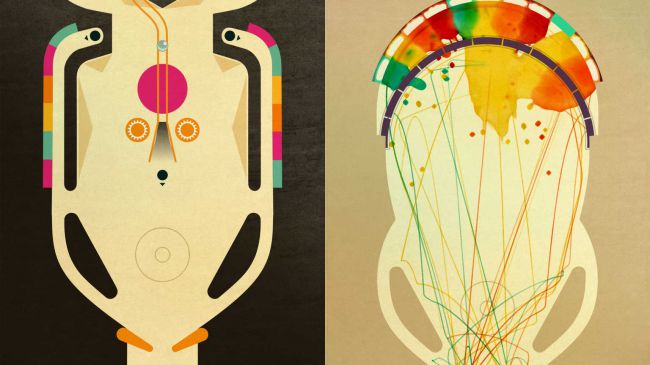
INKS. ($2.99/£2.99/AU$4.49)
Pinball games tend to either ape real-world tables or go full-on videogame, with highly animated content that would be impossible on a real table. INKS. tries something different, boasting a modern 'flat design' aesthetic, and having coloured targets on each table that emit an ink explosion when hit with the ball.
Each of the dozens of tables therefore becomes a mix of canvas and puzzle as you try to hit targets while simultaneously creating a work of art. Neatly, as the ball rolls through ink splats, it creates paths across the table, which is visually appealing and also shows when your aim is off.
Because each level is short — usually possible to complete in a minute or so — INKS. manages to be both approachable enough for newcomers and different enough for experts to get some enjoyment out of.

Badland 2 ($0.99/99p/AU$1.49)
The first Badland combined the simplicity of one-thumb 'copter'/flappy games with the repeating hell of Limbo. It was a stunning, compelling title, pitting a little winged protagonist against all kinds of crazy ordeals in a forest that had clearly gone very wrong.
In Badland 2, the wrongness has been amplified considerably. Now, levels scroll in all directions, traps are deadlier, puzzles are tougher, and the cruelty meted out on the little winged beast is beyond compare. Still, all is not lost - the hero can now flap left and right. We're sure that comes as a huge consolation when it's sawn in half for the hundredth time.

ALONE... ($1.99/£1.99/AU$2.99)
Because of the nature of touchscreen controls, there's a tendency to slow things down on iOS. ALONE… throws such caution to the wind, flinging you along at Retina-searing speed as you try in vain to save a little ship hurtling through rocky caverns of doom.
This is a game that's properly exciting, and where every narrow escape feels like a victory; that all you're doing is dragging a finger up and down, trying in vain to avoid the many projectiles sent your way, is testament to you not needing a gamepad and complex controls to create a game that genuinely thrills.

Power Hover ($3.99/£3.99/AU$5.99)
It turns out the future will involve hoverboards, only it'll be robots piloting them. In Power Hover, all the humans are gone, but so too are the batteries that power your robot village. So you hop on your flying board and pursue a thief through 30 varied and visually stunning levels.
Whether scything curved paths across a gorgeous sun-drenched sea or picking your way through a grey and dead human city, Power Hover will have you glued to the screen until you reach the end of the journey. And although it's initially tricky to get to grips with, you'll soon discover the board's floaty physics and controls are perfectly balanced.
Our favorite iPad games where you find objects cleverly hidden on-screen and use them to escape from virtual prisons.
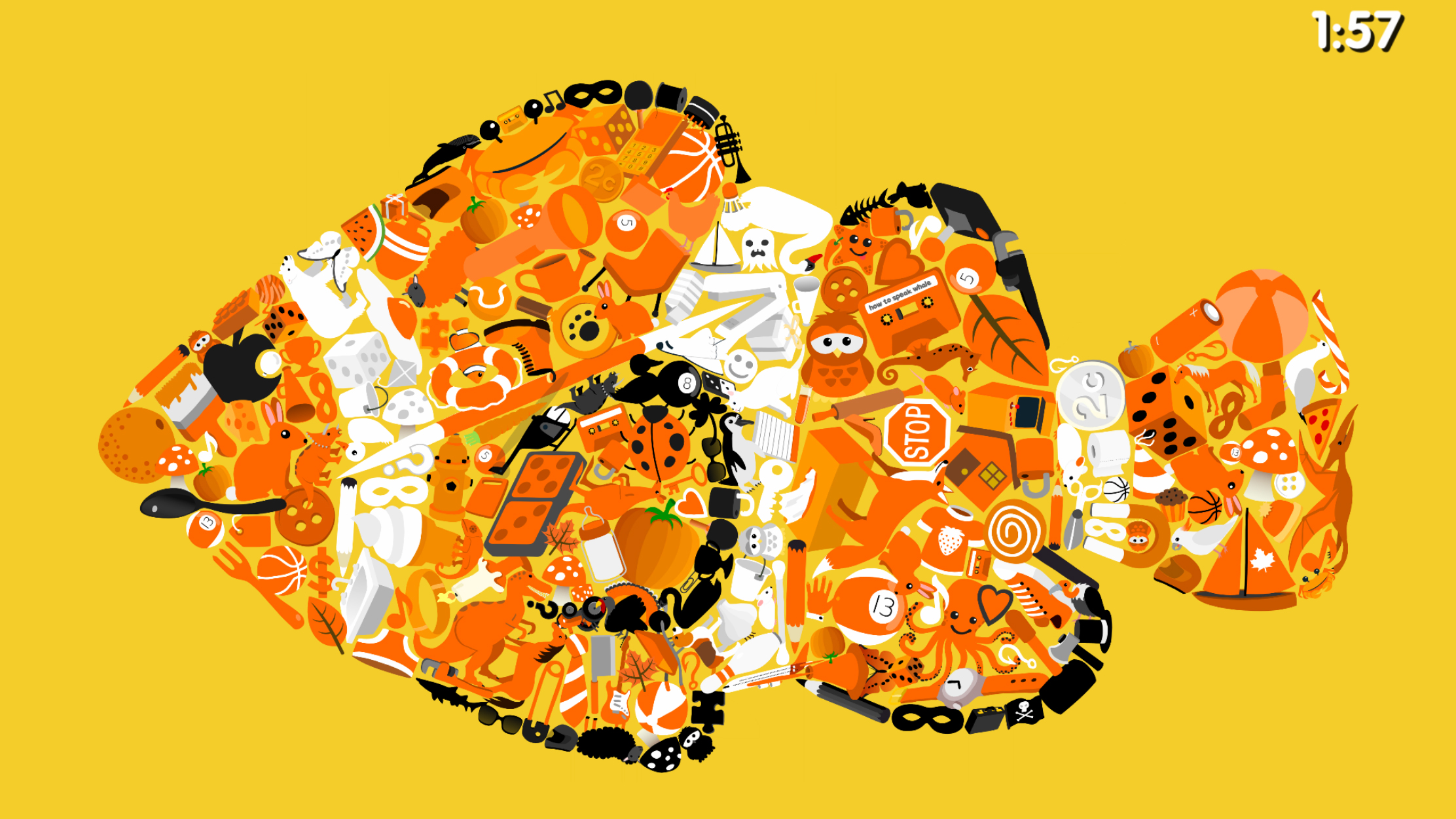
Little Things Forever ($0.99/49p/AU$0.99)
Little Things Forever is the purest example of a hidden object game you’re likely to find on the App Store. There’s no overarching quest – no desire to be a sort-of adventure. Instead, you’re presented with a jumble of objects (that, when you squint, form cartoonish artwork), and things to find.
Depending on the challenge you’re tackling, you either get a full list, and aim to get through it as quickly as possible, or a timer and one item at a time to discover. Sporadically, the game has you complete basic jigsaw puzzles, in order to unlock new levels.
On the iPad’s larger screen, the game shines. It’s full of charm, and although the timers add some incentive for those who need it, Little Things Forever is perfectly relaxed if you feel like taking 'forever' on a single puzzle.
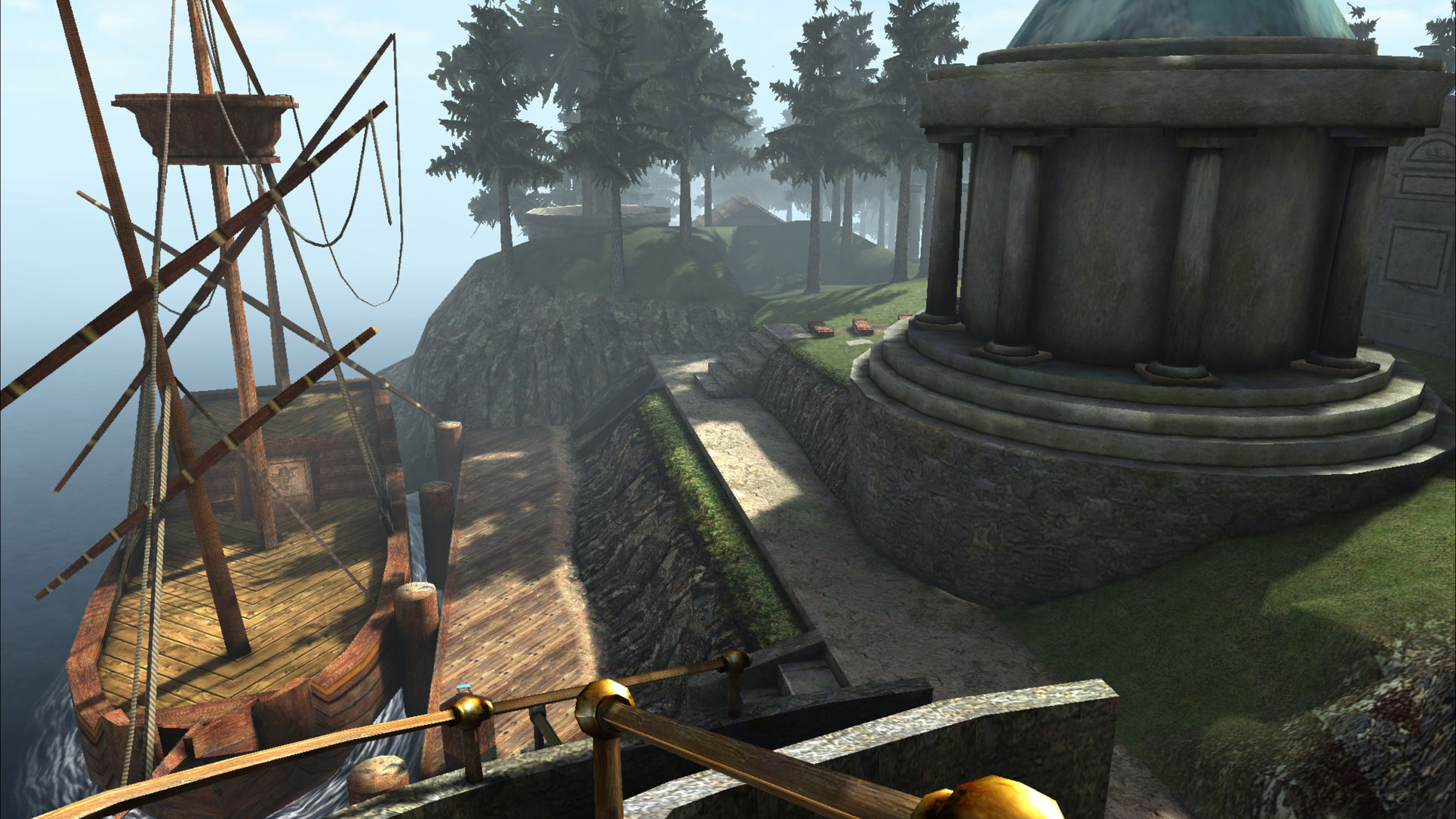
realMyst ($6.99/£6.99/AU$10.99)
realMyst is a new take on Myst, a Mac classic from the early 1990s. It dumps you on a strange island, giving you no clear ideas what to do next. The idea is to explore, check out every nook of the island, find clues, solve puzzles, and find new places in which to poke around.
To say realMyst is obscure is putting it mildly. Its puzzles can be baffling and cryptic, and smart players will arm themselves with a notepad – and a huge amount of patience.
However, this iPad version is a fantastic way to experience a gaming classic, with a more free-form approach to movement, beautiful revamped graphics, and the simple fact you can play it anywhere.
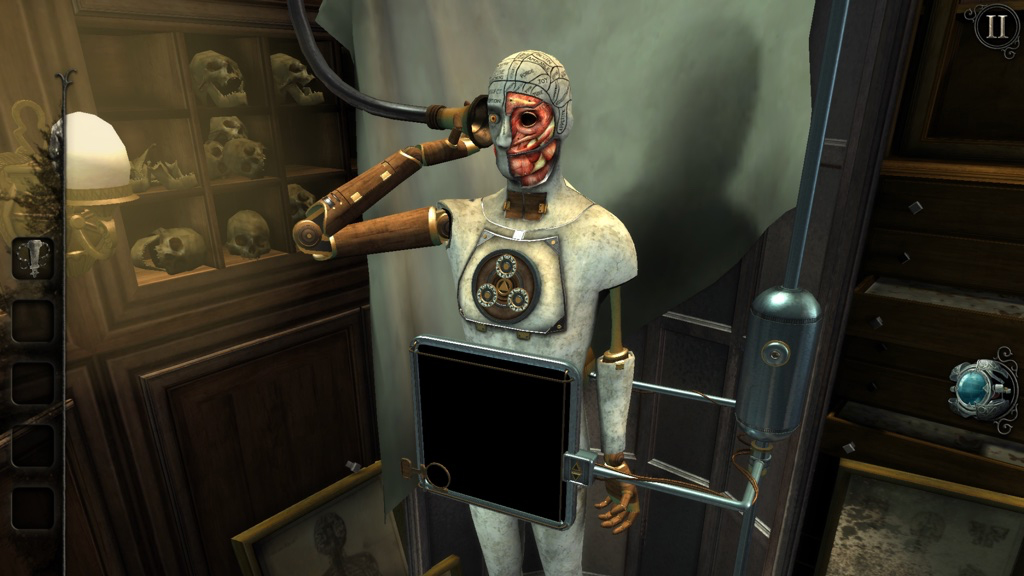
The Room: Old Sins ($4.99/£4.99/AU$7.99)
The Room: Old Sins pits you against devious puzzle boxes. Like previous games in the series, Old Sins is obsessed with the impossible. This time, you’re investigating the disappearance of an engineer and his wife. You spot what appears to be a corpse in a gloomy attic and are abruptly swept inside a doll house.
At this point, it’s all tap, swipe and drag, manipulating objects using your very best logical deduction until things happen. At one point you’ll discover a seemingly unending number of hidden compartments in a tiny model train. Elsewhere, something horrific and otherworldly will scream before forcibly ejecting you from a room.
If you’re a newcomer and puzzle fan, Old Sins is a no-brainer – a superb, coherent title with multiple-location challenges and none of the tedious walking around found in the likes of Myst. As for existing fans, you’ve probably already bought and finished the game anyway. If not, what are you waiting for?

Hidden Folks ($3.99/£3.99/AU$5.99)
Hidden object games are often dull and can be heavy on the pocket, demanding you spend lots of money on IAP. Hidden Folks isn’t either of those things, and has the added bonus of being hugely charming.
You’re presented with hand-drawn scenes, each of which has a strip across the bottom, depicting objects to find. You can tap any of them for a clue, but the scene can also be interacted with, for example to rustle bushes to find someone lurking behind them.
Cute mouth-originated sound effects pepper proceedings, and the pace is varied with differing map sizes, and the odd playable scene, such as helping someone to a destination by adjusting the landscape.
Thus, with its wit and smarts, Hidden Folks very much stands out from the crowd – unlike some of the tiny critters it tasks you with locating.

Grim Legends: The Dark City ($6.99/£6.99/AU$AU$10.99)
Grim Legends: The Dark City lobs you in at the deep end. You’re the member of a secret organization tasked with guarding a powerful artifact – but a rogue agent stole it and unleashed an evil monster. Also, your mind was wiped in a recent mission. You must find the relic, fix the damage the monster’s causing, all while recovering your lost memories.
That sounds like a lot of work, but The Dark City’s fairly gentle in terms of challenge. The puzzles are straightforward – if varied – although the game does shake things up with Rune Battles. These find you fighting with runes, selecting symbols that don’t match your opponent’s ones. This is a nice change of pace, and nicely augments the lashings of atmosphere provided by very smart visuals, and a solid underlying storyline.

The Lost City ($1.99/£1.99/AU$2.99)
The Lost City broadly echoes Myst, in that it places you in a fantastical location, and challenges you to explore. In this case, you’ve discovered the titular city recounted to you by an elderly relative that no-one else believed.
As ever, the game involves examining locations, finding useful-looking objects to stash in your inventory, and using them to unlock pathways to further your adventures. But The Lost City has an intriguing hook: you can change the seasons. So if you can’t get past a river, perhaps you might be able to at a different time of year…
With lush (if static) visions, and a journal that handily automatically tracks symbols and clues, The Lost City proves to be a compelling and atmospheric experience.

All That Remains ($1.99/£1.99/AU$2.99)
All That Remains starts off in a harrowing manner, with you waking up in your father’s bunker. An old two-way radio crackles into life, and your distressed sister explains that the world has gone to hell, and that you’ve been locked up for your own safety. You resolve to rescue her from the chaos.
Unfortunately, your father turns out to be part sociopath, part crazy inventor. Rather than furnish you with a serviceable door handle with which to escape, you must figure out the convoluted path to an exit. Cue: lots of poking around, finding clues, figuring out the meaning behind symbols, and piecing everything together. At its best, this is tense, challenging stuff – ideal if you find your existing hidden object games something of a pushover.

Agent A ($4.99/£4.99/AU$7.99)
Agent A combines an escape game with the swagger of a spy movie. It starts with you following Ruby La Rouge, who obliterates a boat – and your boss. Deciding that’s rather out of order, you break into Ruby’s house – and she locks you in. Presumably the glass is very tough, because you can’t smash through it. Instead, you must figure out an absurdly convoluted path to make your escape.
This game has a pleasingly spiky, angular art style, and breezy responses when you interact with objects. The actual puzzles are perhaps a bit pedestrian, but the game frequently neatly ties together details and clues across multiple locations. Also, rather generously, Agent A has expanded from its initial sole chapter to a five-part episodic tale, offering plenty of espionage bang for your bucks.

Forever Lost ($11.99/£11.99/AU$17.99)
The Forever Lost series (three games, available separately if you don’t want the bundle) begins with you waking up in an unfamiliar room. Freaky as though that is, getting out is simple; the scary bit is it’s clear others have been here before you.
Also, when you do escape your confines, you merely find yourself in the bigger prison of an abandoned asylum. The game then follows a familiar pattern of scanning rooms for objects and clues, using them to move your quest onward.
Although visually bleak and drab, Forever Lost’s atmosphere and weirdness keeps you gripped. And you can’t help but love a game with its own in-game camera, to snap objects for later reference, so you don’t have to manually make notes elsewhere.
Our favorite iPad platform games, including free-roaming adventures, retro-infused titles, and modern console-style classics.

Linn: Path of Orchards ($2.99/£2.99/AU$4.49)
Linn: Path of Orchards is an unconventional platform game, which takes place in a world of dynamic, rotating surfaces. You must help protagonist Aban to each level’s exit, grabbing bling along the way.
Although you can sort of brute-force your way through the game, making use of gestures to dash left and right, and mid-air jump, you’re better off embracing the elegance and thoughtfulness that exists at the heart of Linn. Think of each challenge as a turn-based test, and figure out the optimum sequence of moves to your goal.
Multiple challenges per level, stylish visuals, and a lovely soundtrack further ensure Linn is something special – an engaging mash-up of Monument Valley-style visual minimalism, clockwork structures, and parkour-like sliding and leaping.

see/saw ($2.99/£2.99/AU$4.49)
see/saw is a platform game that features a sadistic professor (whose credentials we’re extremely skeptical of) putting a speedy protagonist through ostensibly scientific tests. Said tests mostly involve the subject collecting coins, but also avoiding hazards. Increasingly frequently as you explore each single-screen room, your untimely demise is the key to reaching the last coin.
Its basic controls – hold the left or right of the screen to head in that direction – mean see/saw works really nicely on the iPad’s large display, but this stripped-back approach to platform gaming doesn’t make for dumbed-down level design. In fact, as you progress, challenges become devious, with you having to figure out how to impale the hero just so, in order to reach that final target.

Spitkiss ($1.99/£1.99/AU$2.99)
Spitkiss is unique in the App Store, what with it featuring tiny creatures that communicate by lobbing bodily fluids at each other. But how you get spittle and the like from one to the other plays like Angry Birds became a single-screen platformer, and then had Matrix-style slo-mo welded to it.
To get started, you aim and fling some spittle, and then direct it from surface to surface until the blob reaches its goal. Hold the screen and time slows, allowing you to prepare your next shot – essential given the claustrophobic and hazard-strewn screens you face.
This all works particularly well on iPad. You’ve plenty of space to move your finger, and can be far more accurate on the larger screen. The vibrant visuals are arresting, too, even if you might feel squeamish about flinging spit.

Suzy Cube ($3.99/£3.99/AU$5.99)
Suzy Cube is a platform game set in a world with a thing for straight edges. Assuming you’ve played a platformer before, you know the drill: explore; grab gold; unsportingly jump on the heads of enemies to obliterate them.
But Suzy Cube goes beyond the stripped-back 2D fare we often see on iOS for something akin to Super Mario 3D Land. This means you may find yourself quickly swapping between skidding down icy mountains in 3D, following Suzy Cube as she runs side-on around a tower, and then delicately leaping between floating platforms, as seen from above.
Bar some duff boss battles, it’s ambitious, entertaining fare, with tight touchscreen controls, and a great sense of pace and variety as you delve into the world and discover its many hidden secrets.
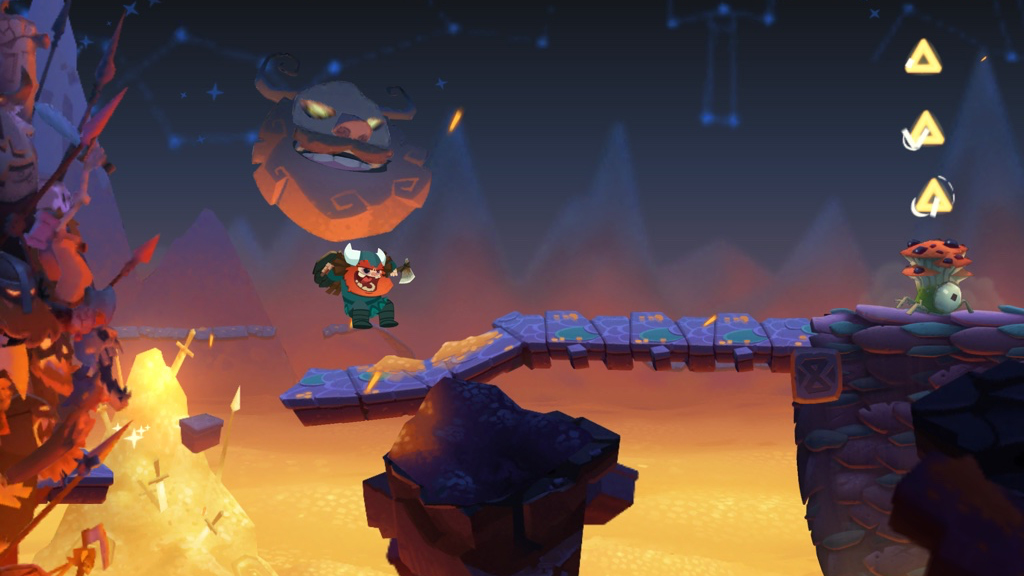
Oddmar ($4.99/£4.99/AU$7.99)
Oddmar is a Viking who’s not good at being a Viking, but he’s forced into action when his village vanishes and an evil takes over the land. Cue: swiftly munching a magic mushroom to get some special powers, followed by quite a lot of platforming action.
And what platforming action! Oddmar looks and feels like nothing else on iPad. Although the gameplay mechanics are familiar (leap about, explore, collect bling, hack up enemies, don’t get killed), the production values here are something else. Oddmar’s world feels alive, and each level has been painstakingly constructed, imbuing the game with smarts and pace.
Peppered with set pieces, survival-oriented ‘dream’ levels, and varied challenges, and blessed with pitch-perfect touchscreen controls, Oddmar is only to be missed if you can’t stand this kind of game. And even then, we suggest taking a look anyway – just in case.
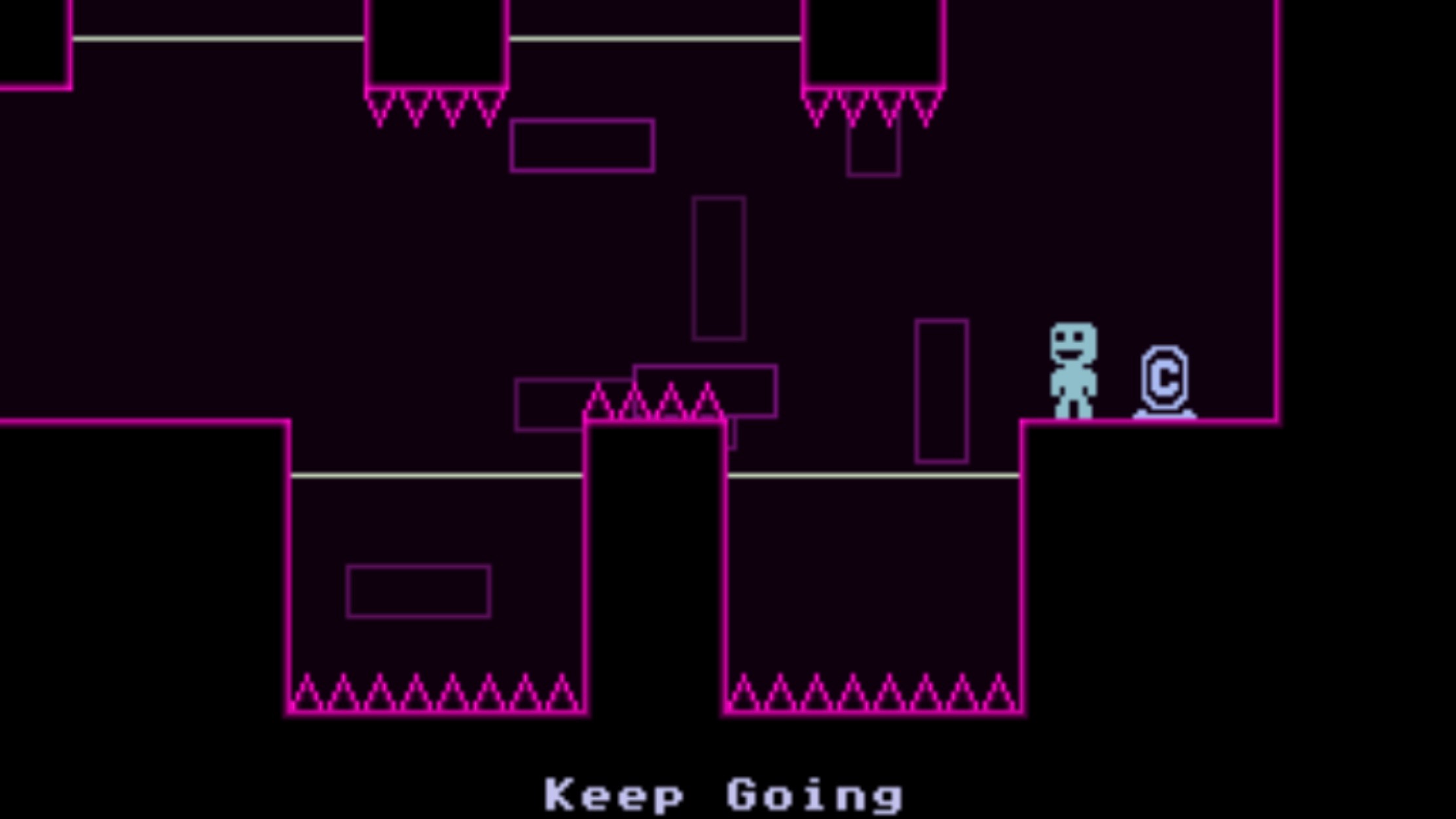
VVVVVV ($2.99/£2.99/AU$4.49)
VVVVVV is an old-school twitch platformer. It strings a bunch of single-screen challenges together, gives them silly names, peppers restart points about, and then sits back with an evil grin as you blunder into traps time and time again.
The main twist is VVVVVV’s use of gravity. Instead of jumping, your running man can switch between ceiling and floor. Most rooms within the game cleverly play with this gravity mechanic. There are bounce pads, roaming enemies, and columns of screens where you weave your way down through columns of spikes, and then head back, all because some nutcase didn’t think to install a small bridge.
Visually, the game is odd – 1980s-style graphics, which also look blurry on iPad. The virtual controls are occasionally slippy too. Mostly, though, it’s a joy (albeit sometimes a head-bangingly frustrating one), with smart writing and clever puzzle-infused level design.
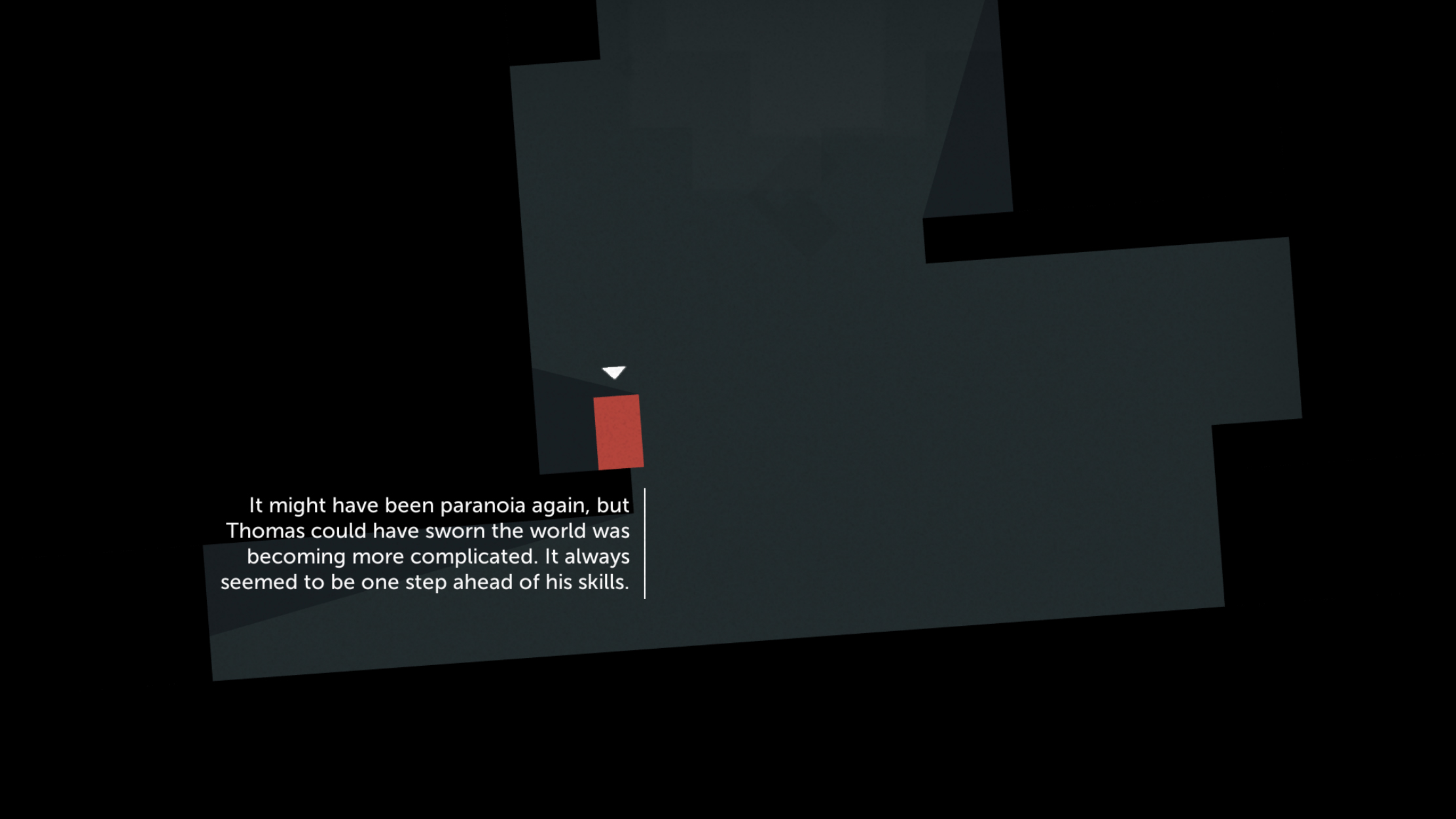
Thomas Was Alone ($4.99/£4.99/AU$7.99)
Thomas Was Alone is a platform adventure that tells the tale of a self-aware artificial intelligence. Said AI is represented as a little red rectangle, charged with leaping about blocky environments, and reaching the exit. Along the way, other AIs appear, each with its own distinct abilities, which you must make best use of to get everyone to their goals.
What sets Thomas Was Alone apart is its storytelling. The little rectangles are imbued with big personalities, and a voiceover gives you a window into their thoughts, which is often meta and frequently entertaining. After all, it’s hard not to love a game that finds the hero peering at certain doom, before the voiceover notes: “Something about the boiling, toxic, glowing water intimidated Thomas. He didn’t like it, and he certainly didn’t want to swim in it.”
Still, you’ll want to swim in this game, because it’s a beautifully realized production.

Mushroom 11 ($4.99/£4.99/AU$7.99)
Mushroom 11 finds you controlling a living pile of green gunge that gloops its way around a post-apocalyptic world. Its mission appears to be hoovering up whatever life is desperately clinging on in this harsh landscape, from tiny spiders to mutated plants that spit fire.
If you had to label it, Mushroom 11 is a fairly traditional side-on platform puzzler, but the manner in which it’s controlled proves transformative. There’s no virtual joystick here – instead, you touch to ‘erase’ bits of the green blob, which then rapidly grows back.
This mechanic is used inventively throughout the game, whether you’re figuring out how to zoom through tunnels, make the blob ‘jump’, or split it in two, so one part can trigger a switch while the rest moves onward. On iPad, the game is one of a kind and a tactile joy.

INSIDE (free + $6.99/£6.99/AU$10.99 IAP)
INSIDE is a puzzle-heavy platform game that charts a boy’s adventures in a chilling dystopia. It begins with him fleeing from armed men. You must duck behind trees and flee from ferocious dogs or end up dead, face-down in the dirt.
But death is not the end; like INSIDE’s predecessor, the equally disturbing LIMBO, the hero here seems doomed to repeat every failure until it becomes a victory.
It’s trial and error time, then. You run through a building, get horribly killed, take some mental notes, and then try again. Occasionally, this gets old; some sequences in the game are too long, and a couple have a margin of error that’s too tight.
For the most part, though, this is a game of intriguing puzzles and a mesmerizing – if extremely dark – world, packed full of surprises, horror and tiny victories.

Mos Speedrun ($0.99/99p/AU$1.99)
Mos Speedrun is an engaging speed-run Mario-ish platform game, featuring a little bug zooming through 25 hand-crafted levels. The crude visuals feel decidedly old-school, featuring the usual floating platforms and patrolling enemies that mostly lack even the slightest hint of intelligence.
But Mos Speedrun turns out to be one of the finest games of its kind on iPad.
First, the level design is really smart, forcing you to learn the precise position of every platform, gap, and enemy, if you want to beat the speed-run target. Secondly, each level has alternate targets – finding a hidden skull, and collecting all the loot – that boost replay value, but also force you to shake up your approach.
Finally, Mos Speedrun amusingly subverts the idea of ‘ghost’ replays. Die a lot and you end up battling your way through a level alongside the spirits of the fallen from your previous failures. It’s bonkers – and humbling – when dozens of the things are skittering about.
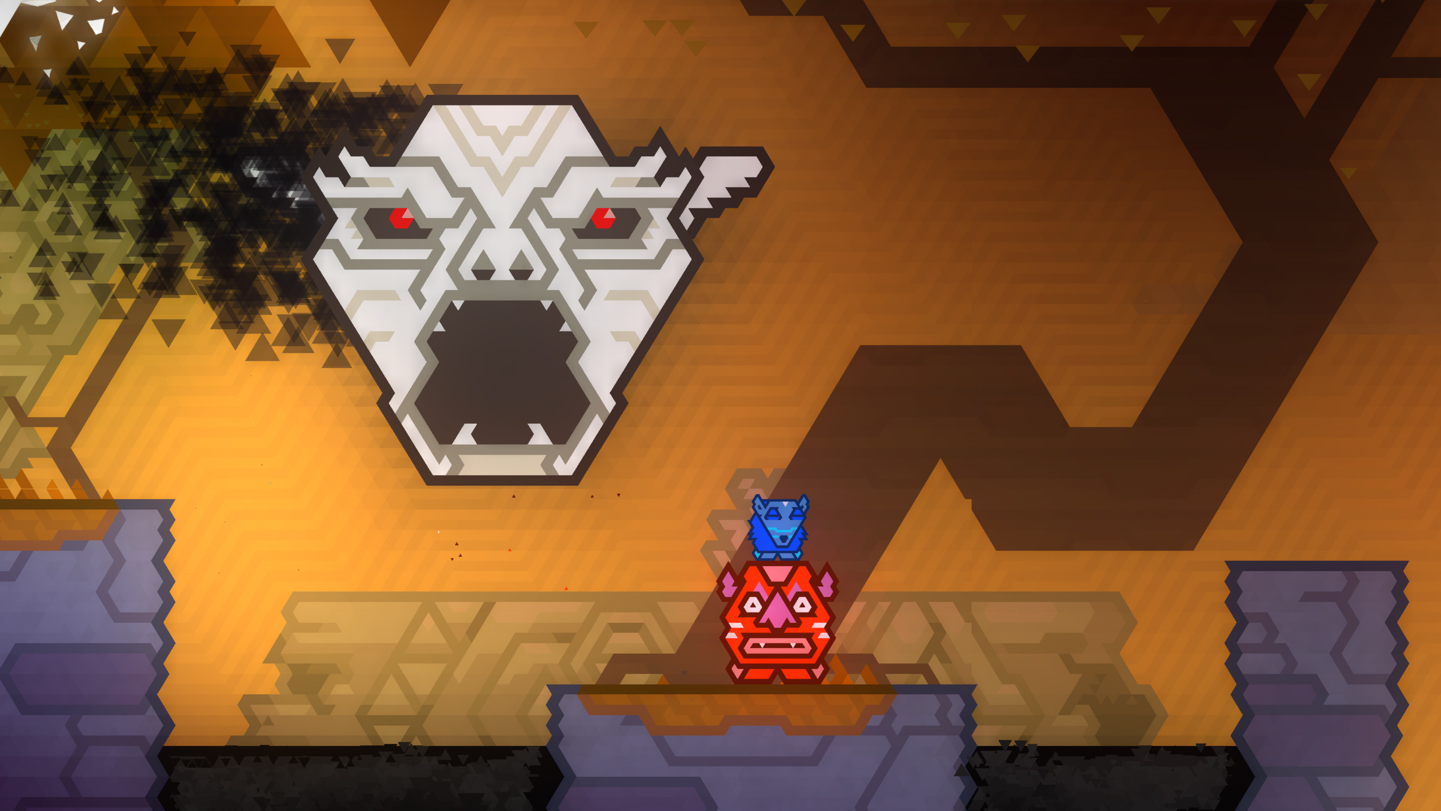
Kalimba ($3.99/£3.99/AU$5.99)
Kalimba is an inventive and compelling platform game for people bored with controlling just one character at once. Here, you help two colored totem pieces avoid deadly pits and roaming enemies – and you control both simultaneously.
Initially, you’re eased in by way of a split-screen set-up where the totems don’t meet. At all times, you must be mindful that when one totem’s on safe ground, the other may be seconds from doom. And then the game really starts shaking things up.
You’re soon faced with color barriers that force you to repeatedly swap the totems around, the prospect of ‘stacking’ and double-jumping to reach gems, gravity flipping, totems that fly through the air while their partners very much don’t, and chase sequences featuring massive, terrifying bosses.
If it’s all a bit much alone, there’s a superb two-player single-device mode – although how much actual co-operation there’ll be when you’re juggling four totems and your friend hurls you into a lava pit, it’s hard to say.

Traps n' Gemstones ($4.99/£4.99/AU$7.99)
Traditional platform games often fare poorly on iPad, but Traps n' Gemstonesbucks the trend. Its approach is resolutely old-school, from the on-screen controls to the Metroid-style gameplay that involves exploring a huge interconnected world, opening up new passageways by finding and correctly using objects.
The theme, though, is more Indiana Jones. A little chap, armed with a whip and with a fedora on his head, leaps about a pyramid, grabs loot, and gives mummies and snakes a good whipping. Interestingly, the game simultaneously manages to appeal to casual and hardcore gamers.
Progress doesn't reset, meaning you can keep getting killed but gradually work your way into the bowels of the pyramid. But your score reverts to zero when you come a cropper; getting into the thousands is therefore a big challenge for those who want to take it.

Drop Wizard ($1.99/£1.99/AU$2.99)
Drop Wizard is a single-screen effort that initially resembles a tribute to arcade classics Bubble Bobble and Snow Bros – but it turns out Drop Wizard is a very different beast.
It's part auto-runner, which might infuriate retro-gamers, but this proves to be a brilliant limitation in practice. Your little wizard never stops running, and emits a blast of magic each time he lands. You must therefore time leaps to blast roaming foes, and then boot the dazed creatures during a second pass.
This is a vibrant, fast-paced, engaging game. And since you you only ever move left or right, it’s nicely optimized for touchscreen play.
Our favorite iPad brain-teasers, logic games, sliding puzzlers, match-three games, and path-finding titles.

Snakebird Primer ($7.99/£7.99/AU$12.99)
Snakebird Primer features worm-like birds that live on strange levitating islands. The grumpy tube-like avians spend much of their time asleep, or making strange burping noises, but are tasked with reaching a portal. Your aim is to figure out how to get them there.
Despite each level only being a single screen in size, there’s plenty of imagination and complexity in the routes you have to take. Sometimes, you must make birds eat fruit, whereupon they grow, and can be used as bridges for other birds. Elsewhere, you need to manipulate massive Tetris-like blocks someone’s left lying around.
Veteran gamers may find the going a bit easy, but every one of Snakebird Primer’s levels is grin-inducing fun; and if on completion you hanker for a tougher test, there’s always the original – and brain-thumpingly difficult – Snakebird.
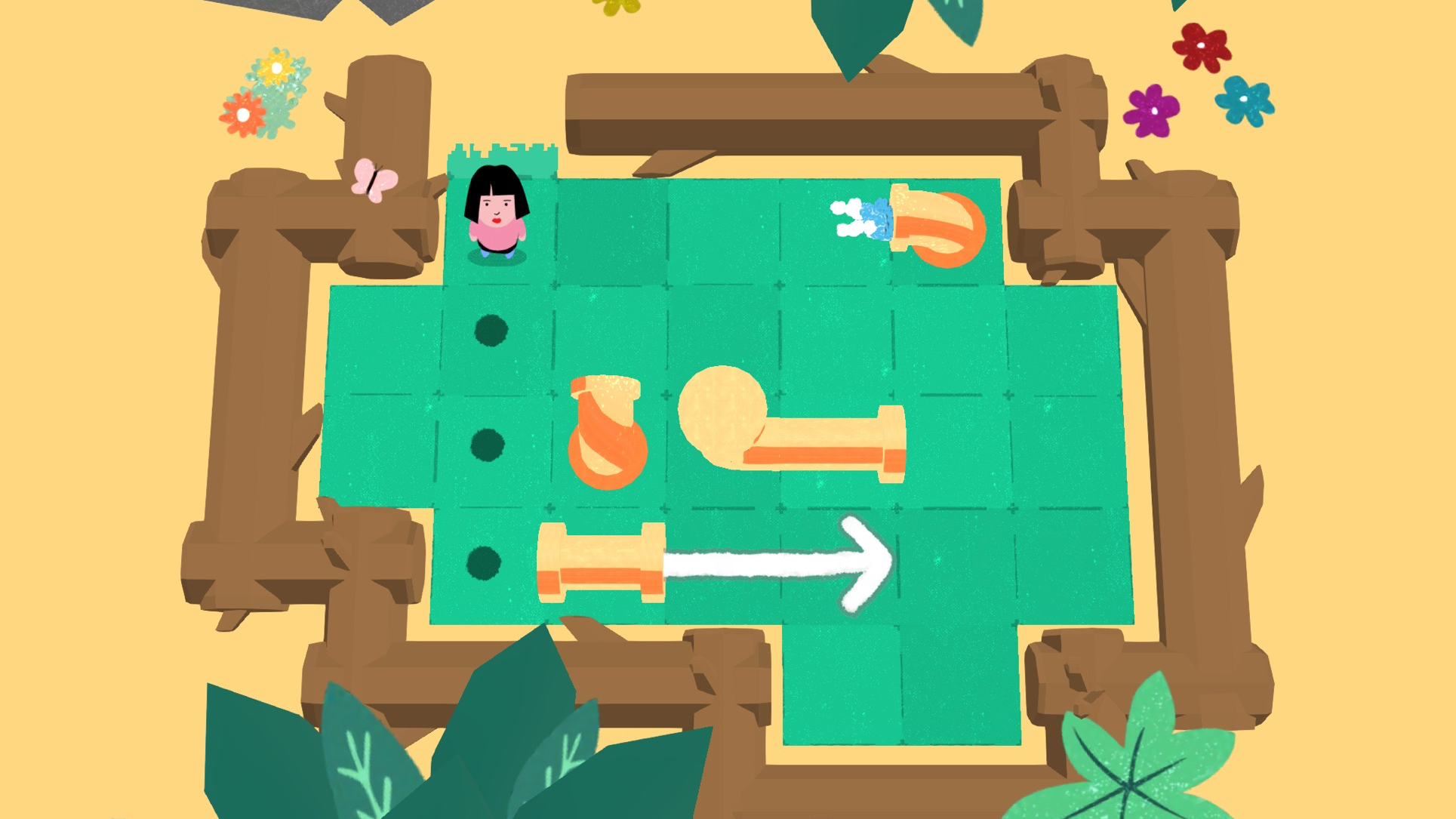
Pipe Push Paradise ($3.99/£3.99/AU$5.99)
Pipe Push Paradise is a puzzle game about pipework. You’ve arrived on a desert island that has some seriously dodgy plumbing. The aim is to get the water flowing, albeit not in the usual manner. Here, the pipes are massive and strewn about claustrophobic grid-based rooms.
The only way to get things working is to shove them into place. There’s more than a hint of box-shifting games like Sokoban here, but Pipe Push Paradise adds some twists of its own. Move pipes in a certain way and they rotate. Other times, they must be dumped into pits.
These new ideas radically shake things up, and complicate puzzles that might otherwise have been simple. Although the controls are occasionally a touch fiddly, Pipe Push Paradise proves to be a superb, sunny brain-smasher.

Tiny Bubbles ($3.99/£3.99/AU$5.99)
Tiny Bubbles is a match puzzler set in an underwater world of colorful bubbles. The aim is to match and pop four bubbles of the same color; with luck, this will set off a chain reaction.
Things can never be quite so easy for long, and so Tiny Bubbles lobs various hurdles into its warm bath of delights, such as fish that dart about and inconveniently add new bubbles, and color-mixing. Eventually, you’ll unlock the arcade mode, which tests your reflexes as well as your brain, for example having you keep bubbles within a boundary as new ones are created.
Great-looking, mostly relaxing, and always engaging, Tiny Bubbles is an excellent buy. Also, there are few things more satisfying than popping loads of bubbles – even if they’re on a screen.

Where Shadows Slumber ($4.99/£4.99/AU$7.99)
Where Shadows Slumber has a lush, minimalist art style with more than a whiff of Monument Valley about it, but instead of having you manipulate impossible architecture, Where Shadows Slumber has you rework the landscape by casting shadows across it.
This all happens by way of your lamp. Position yourself just so and structures will shroud an area in darkness; when it’s subsequently lit, what was a hole may become a bridge, or an impassable doorway may be opened.
It’s a captivating organic adventure, where you figure out the rules as you go along.There’s also darkness in this world beyond the shadows, with villainous creatures who’ll seemingly stop at nothing to rob you of your light.

Blask ($1.99/£1.99/AU$2.99)
Blask is a world of laser beams and mirrors. Your goal is to direct each laser beam to a target. One brief light show later, it’s on to the next test.
This in itself is nothing new – there are loads of games for iPad where you bounce lasers around – but Blask transforms each level into a set of puzzle pieces. As you manipulate what appears to be a single ‘room’ beneath your fingers, it breaks into pieces, lasers refracting within.
There’s a tactile joy in experimenting with recombining shapes, moving those that aren’t fixed down, and figuring out the precise setup that allows you to complete your goal. It’s perhaps a touch finicky and twitchy at times, but otherwise Blask is a game that feels perfectly suited to sit-down iPad play.
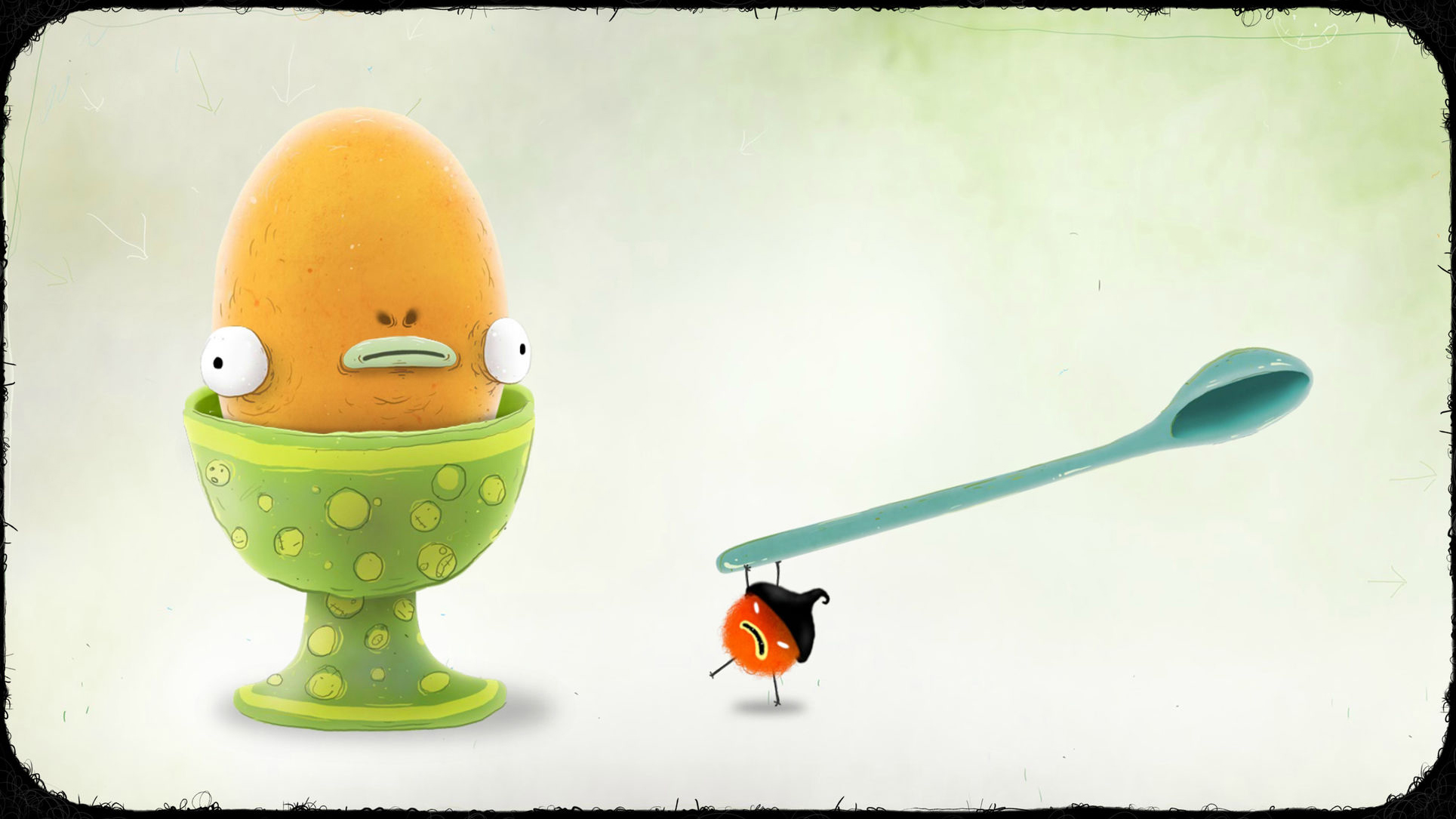
Chuchel ($4.99/£4.99/AU$7.99)
Chuchel is part puzzler, part interactive cartoon - and a decidedly strange one at that. It features an angry ball of fluff who’s determined to eat a cherry, but every time he gets the fruit, it’s snatched away by a giant hand seemingly on loan from Monty Python.
Your part is to help Chuchel get the cherry, mostly by tapping hot-spots to decide his next action. These unleash canned animations, most of which – in classic cartoon fashion – result in Chuchel falling over or otherwise failing at his task.
This isn’t the most cerebral of puzzle games – far from the brain-smashing fare you might expect from creators Amanita Design – and it can be a grind if you have to play through a section a number of times before cracking the correct sequence. Nevertheless, Chuchel is full of so much charm and weirdness that it’s easily worth the outlay.

7 Billion Humans ($4.99/£4.99/AU$7.99)
7 Billion Humans takes place in a world run by benevolent robots who do all of the work. But, of course, the humans still aren’t happy, and so the robots give them jobs – stupid, pointless jobs. In effect, doddering folks become parts of a living computer, and you’re tasked with ‘programming’ them to pick up boxes and put them down somewhere else.
It sounds dull, but it’s actually riveting. Like predecessor Human Resource Machine, this is a game that takes real-life programming concepts and infuses them into a turn-based puzzler.
On the iPad particularly, the drag-and-drop interface for crafting coding logic works wonderfully, and the screen’s big enough that you can spot precisely what’s going on with your work. The larger display doesn’t hurt when taking in the bitingly satirical (but generally good-natured) cut-scenes either.

Golf Peaks ($2.99/£2.99/AU$4.49)
Golf Peaks might look a lot like a mini-golf game, but it’s really a strategic turn-based puzzler that takes place on tiny angular golf courses hewn into rectangular hillsides.
Each round has you try to get the ball in the hole, only instead of aiming and firing, you use movement cards, and only state the direction in which you want the ball to travel.
This is child’s play when your ball’s one square from the hole and you have a ‘move one square’ card, but when you’ve all manner of jumping and movement cards and are staring at a complex course packed will hills and hazards, this seemingly simplistic golfing puzzler takes on new dimensions.

Persephone ($3.99/£3.99/AU$5.99)
Persephone looks like a pretty run-of-the-mill isometric puzzler. There’s an exit you have to reach, which requires you to do things like shove boxes about and flip switches. But then you fall into a ditch, die, and the game… carries on going, with you controlling your resurrected self.
Your corpses (you can have up to three) are then used to great effect, in the sense of adding to the complexity of the puzzles, but also in being darkly comic. It’s hard to think of any other iOS puzzler where you must shove a line of dead ‘yous’ along, in order to trigger a switch.
This is another great example, then, in how a twist can shake up a well-worn format, making it new, interesting, unique, and – in this case – more than a little macabre!

ELOH ($2.99/£2.99/AU$4.49)
ELOH is a chilled-out puzzle game that wants you to find your inner groove. Each single-screen level has you send blobs from loudspeakers to goals, bouncing them off of various objects. Some of those objects are masks, which can be used to change blobs’ colors, so they match their target goals.
This is a game of order, played to a background beat, and with precise 90-degree bounces. But the game also wants you to gradually carve out a solution by playing the puzzle live. This is especially useful when you find yourself facing increasingly complex layouts that demand labyrinthine paths to be constructed.
On iPad, this all works particularly well – the larger display makes everything a lot clearer, and objects are easier to work with. Having the music pump out of louder speakers doesn’t hurt either!

In the Dog House ($2.99/£2.99/AU$4.99)
In the Dog House is a sliding puzzler that has a cute veneer yet plenty of bite. It features a mutt in an oddball house with moving rooms and lifts aplenty. Its only goal in life is to get to a bowl of dog food, irritatingly (from the pooch’s standpoint) situated on the far side of the dwelling.
Your job is to slide corridors, elevator shafts and other bits of building around, using a bone to urge the ravenous canine onwards. As ever with this kind of game, you must think several moves ahead because the space you have to work in is extremely limited.
Linear level unlocking can be frustrating when you get stuck, but In the Dog House is otherwise a furry good game that will give you paws and hound your brain until you complete the entire tail. (Sorry.)

Evergarden ($4.99/£4.99/AU$7.99)
Evergarden is a strategy-oriented match game set in a fantastical forest of geometry and surprisingly demanding wildlife.
Every game begins as a hexagonal grid on which flowers of varying sizes are arranged. Each of your limited turns has you work through the flowers, deciding whether they should spit a seed into an adjacent space, or combine with a matching bloom. It comes across like a glossy and noodly gardening take on Threes!
But there’s more to Evergarden than these basics. Creature guide Fen makes demands that hugely ramp up your potential for high scores when achieved, and a narrative plays out alongside the puzzles.
This adds extra heart to the game, but also depth – things you find on your journey unlock new strategies, and provide added impetus for doing even better during your next go.

Donut County ($4.99/£4.99/AU$7.99)
Donut County is a story-led puzzle game where you play as a hole in the ground. As you consume items, you get bigger; so whereas at first you might be able to gulp down a tin can, you’re eventually guzzling vehicles, houses, and mountains.
All of this happens alongside an oddball storyline featuring a naughty raccoon who’s been sending people the hole rather than the donuts they’ve ordered. Everyone’s now underground, figuring out how to get back to the surface.
The game doesn’t take more than a few hours to complete, not least because only a few levels tease the brain beyond the simplest of challenges. However, the journey is wonderful, especially on the iPad – the bright visuals shine, and the larger canvas makes dragging the hole around, gobbling everything in sight, all the more pleasing.

Scalak ($1.99/£1.99/AU$2.99)
Scalak is all about matching shapes, finding patterns in objects, and spatial awareness. It begins easily enough: you’re asked to drag a square piece to a square hole – hardly the toughest challenge you’ll have faced on iPad!
But across Scalak’s dozens of levels, the game gradually increases the complexity of the objects you face, which eventually resemble exploded 3D jigsaws. You start rotating and moving the central section, and must place pieces that have been bent across multiple planes. Elsewhere, you construct frameworks on to which other pieces connect.
With no score nor timers, Scalak becomes all about interaction – a tactile, stress-free game of exploration and puzzle solving that’s ideal on the iPad’s large display.

Bring You Home ($2.99/£2.99/AU$4.49)
Bring You Home is a puzzler featuring rotund alien, Polo, who’s on a mission to rescue a kidnapped pet. The snag: the ‘petnappers’ have a habit of darting through portals.
What follows are dozens of single-screen scenes where you figure out how to reach an exit, but instead of controlling Polo, you rearrange and swap out sections of the scene, before pressing a button to see how things then play out.
If you’ve played Framed, Bring You Home is in similar territory, but is far more varied – Polo at various points ends up in living paintings, a bizarre alien circus, and a graveyard where you deal with spooky adversaries.
It’s adorable, silly, and relentlessly imaginative, and the failure animations are entertaining to the point you’ll want to go back and screw things up should you chance upon the correct solution first time round.

Gorogoa ($4.99/£4.99/AU$7.99)
Gorogoa is a perplexing puzzle game that plays with your perception of space, and challenges you to find links between images that aren’t remotely obvious on an initial glance.
The entire thing takes place in a two-by-two grid, within which comic-book panes can be opened up and manipulated. Often, part of an image can be separated and overlaid on another.
For example, a stairs overlay may enable the protagonist to reach a previously inaccessible space, or what appears to be a star-like decorative element might be a cog in an impromptu machine.
Occasionally, Gorogoa baffles; later on, you may hit mental dead-ends, juggling various components, locations and possibilities in your head. But as a tactile, novel, engaging puzzler, there’s little else like Gorogoa on iPad – and you’ll feel like a genius when you reach its conclusion.

GNOG ($4.99/£4.99/AU$7.99)
GNOG is bonkers. It features nine floating heads, which are gateways to miniature worlds of interactive animated madness that you poke, prod, tap and swipe to make things happen.
Your tasks are often quite mundane: fix a spaceship; feed some birds; recover chests from the ocean depths. But the presentation disarms - all bold shapes, primary colors and bloopy audio, like a children’s toy hopped up on sugar. It goes even more psychedelic when you complete a level and the head starts mooing.
If you’re making a face yourself at that particular thought, just grab GNOG and delve deep into an entertainingly madcap game of exploration that revels in the joy of discovery. Fire up the AR mode, plonk GNOG’s strange toys on a table, and you’ll wish real toys were even half as much fun to play with.
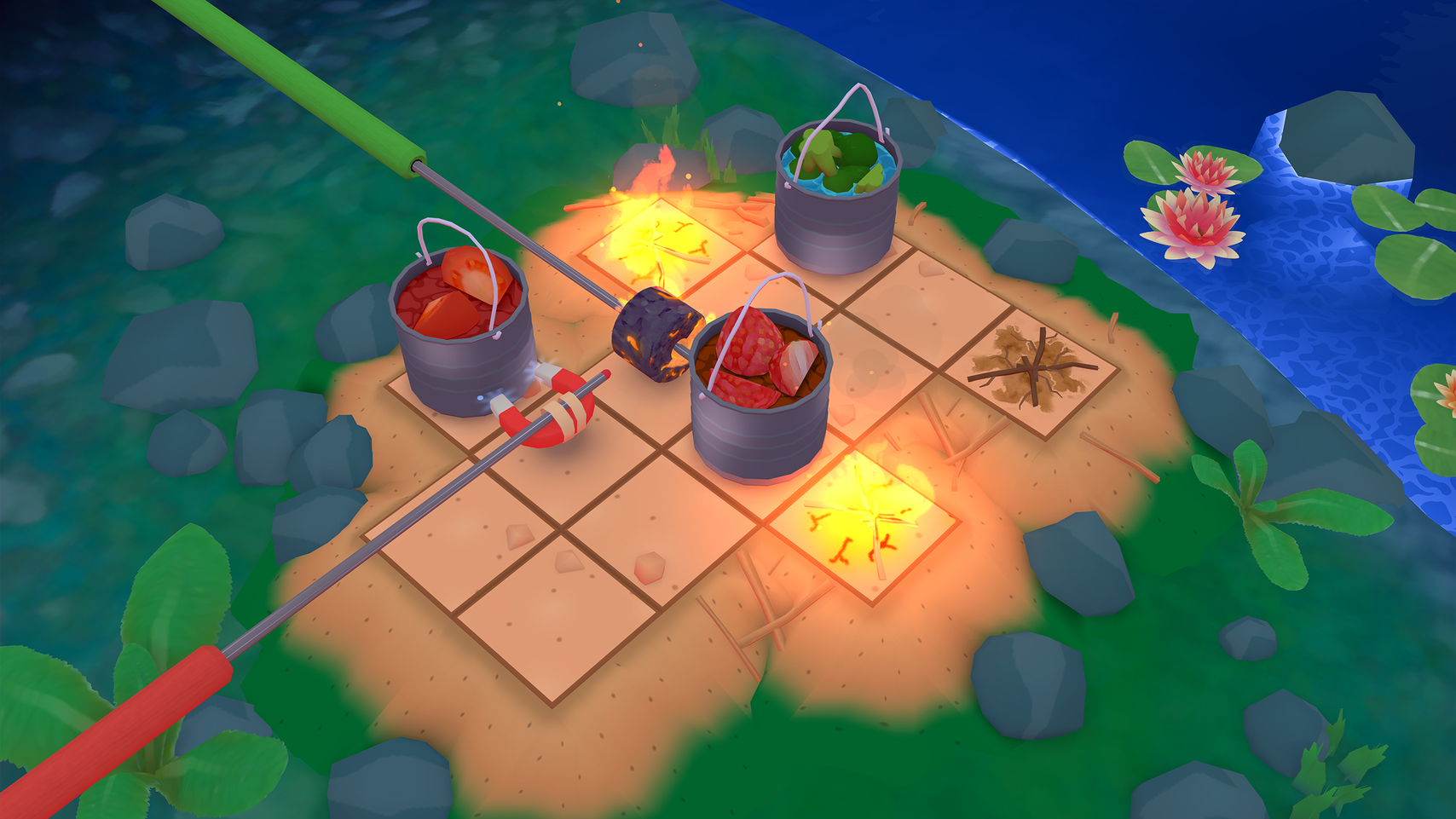
Campfire Cooking ($3.99/£3.99/AU$5.99)
Campfire Cooking seems to simulate the joy of cooking around a campfire – if everyone wanted to make the process as awkward as possible. Fires are set about a grid. Move your stick left or right and your marshmallow flips upside down. You must toast both sides just once – burnt treats will not be tolerated.
The campfire’s set-up rapidly increases in complexity, too, giving you multiple sticks that can nudge others, sticks that spin, meals in pots that must also be cooked, and magnets to drag the metal pots around.
It’s totally ridiculous but hugely compelling, and the game looks superb on the iPad’s display. The larger device also works well with Campfire Cooking’s ‘physicality’ – although you will at times want to yell: “Just point your stupid marshmallow at the fire already.”

Monument Valley 2 ($4.99/£4.99/AU$7.99)
Monument Valley 2 echoes its predecessor in having you explore isometric Escher-like worlds packed full of optical illusions. The aim in each level is to reach a goal, which is often achieved by manipulating the landscape, creating pathways that in the real world simply could not exist.
It’s a visually stunning game, with tiny levels crammed with vibrancy and details, making it ideal for the iPad’s larger display. The narrative featuring a mother and daughter also satisfies, but is careful to leave the experience with a sense of mystery. The levels are diverse in feel, demands, and structure.
If there’s any downside it’s that Monument Valley 2 is short and largely bereft of challenge. But treat it as a couple of hours immersed in a unique and beautiful universe and you’ll find it’s well worth the outlay.

Causality ($1.99/£1.99/AU$2.99)
Many path-finding puzzlers have you use arrow tiles to direct auto-running critters to goals. (Long-time gamers may fondly remember ChuChu Rocket! as a shining example).
Causality is in similar territory, only you also get to control time itself, by dragging up and down the screen.
Early on, this primarily allows you to fix errors – going back to try again when a sprinting astronaut is eaten, or when you run out of your limited number of steps. Before long, though, you’re hurling people through time portals, so they can assist their past selves.
It’s mind-bending stuff, but also one of the finest puzzle games of modern times. It’s also perfect for iPad, due to its visually dazzling and tactile nature.

Splitter Critters ($2.99/£2.99/AU$4.49)
The basic mechanics of Splitter Critters resemble 1990s arcade puzzler Lemmings, in that you guide marching creatures to a goal. But whereas you armed lemmings with tools, Splitter Critters has you slice up the screen with a finger, so you can adjust the landscape to create new pathways.
This is clever, but Splitter Critters isn’t done. The undo button reverts your last cut, but not the position of critters. Undo therefore becomes a device vital for completing levels, rather than merely a means of reverting errors.
Throughout its length, the game keeps adding new elements, such as ocean worlds and a grim underground base full of critter-frying lasers. And although the challenge never rises above slight, the charm and tactile nature of Splitter Critters makes it a joyful journey, especially on the iPad’s larger display.

Twisted Lines ($2.99/£2.99/AU$4.49)
Twisted Lines is another great iOS puzzler with simple rules, but also level design seemingly created to drive you to despair. Each of the 100 levels involves you directing a little colored block that leaves a trail of two colors, but should you cross over the trail, your block changes color to match the first line it hits.
This is pretty important, given that your task is to scoop up colored blocks littered about claustrophobic, deviously designed single-screen puzzles. From the start, Twisted Lines is a pleasingly tricky challenge, and it keeps adding further complications – trail erasers; teleporters – to keep you on your toes.
If there’s any drawback to the game, it’s the strict linear unlock of levels (presumably, this is designed to urge you to grab hint IAPs if you get stuck). But other than that niggle, Twisted Lines is a brain-teaser among the very best on iPad.

Telepaint ($2.99/£2.99/AU$4.49)
In Telepaint, a semi-sentient wandering paint pot wants nothing more than to be reunited with a brush. The tiny snag: it appears to be stuck in a world of brain-bending maze-like tests, comprising single screens of platforms and teleporters. Your goal is to figure out a route, avoiding pot-puncturing spikes and a clingy magnetic 'friend' - a task that becomes increasingly baffling and complex.
You're helped along a little by VCR-style controls that let you pause for breath, and these often become key to solving puzzles, enabling you to switch teleport triggers while everything else on-screen remains static. Even then, the going's tough.
Still, while Telepaint has the propensity to make your head hurt like having a paint can dropped on it, this is a colorful, unique and enjoyable iOS puzzling classic that's not to be missed.

A Good Snowman Is Hard To Build ($4.99/£4.99/AU$7.99)
The little monster at the heart of A Good Snowman Is Hard To Build, wants some friends, and so sets about making them from crisp snow covering the ground. But as the game's title states, making snowman is hard — largely because of strict rules governing the monster's universe.
Snowmen must comprise precisely three balls of gradually decreasing size, and any snowball rolled in the snow quickly grows. A Good Snowman therefore becomes a series of brain-bending puzzles - part Soko-Ban, part Towers of Hanoi - as you figure out how to manipulate balls of snow to build icy friends for a monster to hug.
Our favorite iPad 3D, space, retro, top-down, and on-rails racers.

Need for Speed: Hot Pursuit ($4.99/£4.99/AU$7.99)
Need for Speed: Hot Pursuit [US store] | [non-US stores] is an old-school high-octane racer that echoes pursue-and-smash classic Chase HQ. You tear along in your police car, aiming to batter nasty criminals into submission. Then, during your downtime, you and your cop chums partake in dangerous high-speed races.
Visually, Hot Pursuit is sometimes a touch crude, with background pop-up betraying the original game’s age, but the cars and roadside objects still look nice enough on a Retina iPad. Most importantly, the game feels really good – not least during moments when you fire up the nitro, drift round a bend, and smash the baddie into a roadblock. And if you don’t fancy being the fuzz? You can leap into your sports car in a parallel storyline and become mouse rather than cat.

Grid Autosport ($9.99/£9.99/AU$14.99)
Grid Autosport feels like the first of a new breed of iPad games, where a claim of ‘console quality’ isn’t hyperbole. This really is a pretty much direct conversion of the hit PC and PlayStation racer, squeezed into your iPad.
There’s no messing about with grinding and currencies here – you can immediately delve into everything the app has to offer, choosing from its huge range of challenges, cars, and circuits. Everything from a quick race in an open-top to a full Touring Cars season is just a few taps away.
With a range of control options and difficulty settings, the game manages to cater to arcade fans and simulation nuts alike; and when armed with an iPad and an MFi controller, the only thing betraying the fact you’re not playing on a console is the size of the screen.

Fluid SE ($0.99/99p/AU$1.49)
Fluid SE appears to have arrived from the unholy union of Pac-Man and a brutally difficult time-trial racer set in a hostile underwater world of black fish and deadly red ghosts.
Each test has you zoom about, scooping up dots, and attempting to beat time targets. If you’re fast enough, you get the stars needed to unlock new levels; if not, you’ll need to work on shaving fractions of a second off of your best times.
The snag is levels rapidly increase in complexity, and dots you eat spawn the aforementioned ghosts, which relentlessly chase you around the screen. There are ways of dealing with them, but often that involves slowing down.
Fluid SE therefore becomes a thrilling game of risk versus reward, where everything plays out at breakneck speed – right up until you’re devoured by an angry ghost.

Reckless Racing HD ($0.99/49p/AU$0.99)
Reckless Racing HD is a top-down racer that first graced the App Store way back in 2012. It’s different from its contemporaries in having you coax battered vehicles around ramshackle tracks.
There’s no slick tarmac – bar a mall parking lot that forms part of a course. More often, you’re zooming about the likes of a wrecker’s yard, or dirt roads near an old church that rises majestically out of the screen like it’s about to poke you in the eye.
Given a 64-bit reprieve in mid-2017, Reckless Racing HD is a fantastic blast from the past. The cars have a great sense of weight – the physics when racing is just about perfect. And although it now looks a bit rough and ready, it’s decidedly more reckless (and fun) than its overly polished sequel, and includes the online multiplayer that the most recent entry in the series lacks.
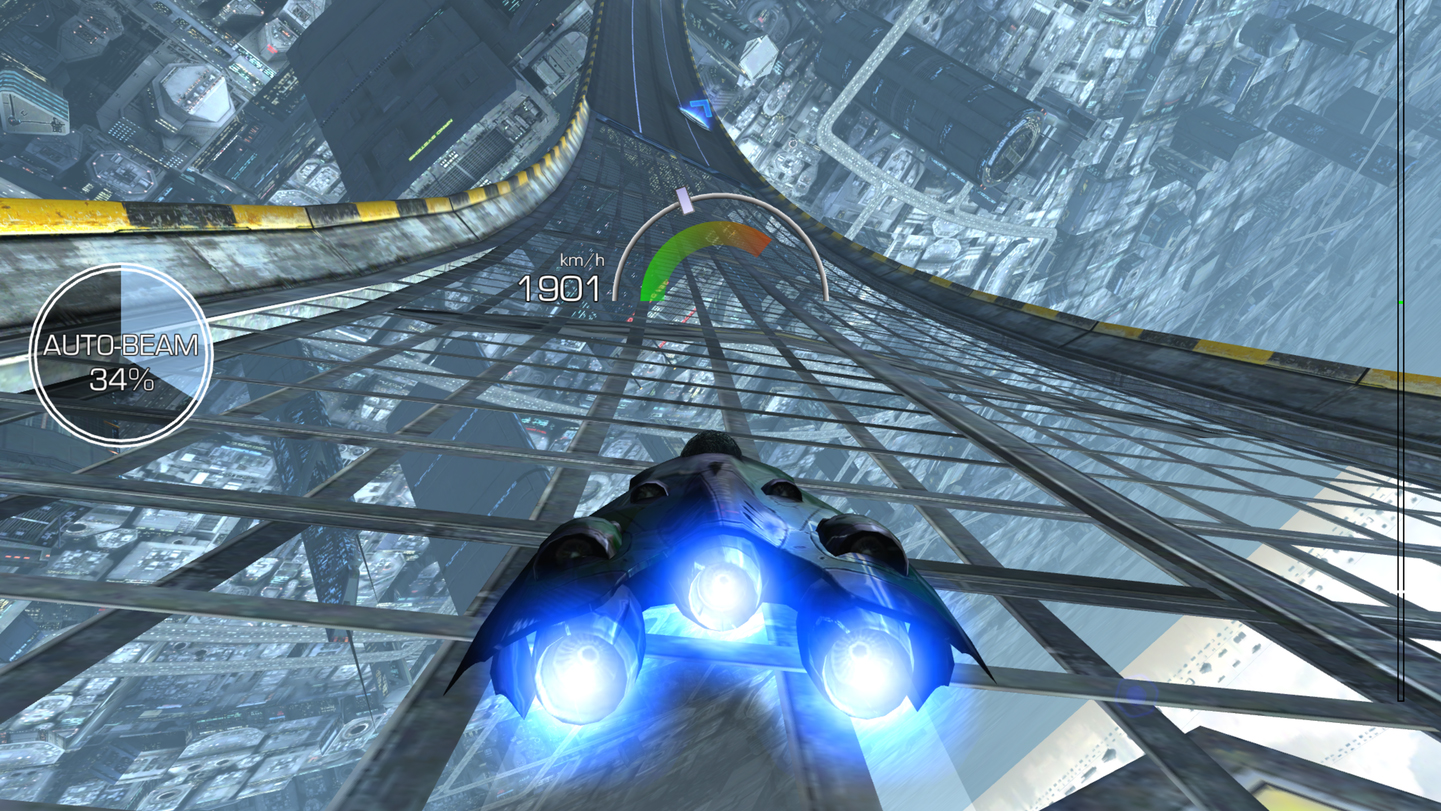
AG Drive ($2.99/£2.99/AU$4.49)
In the future, it turns out people have tired of racers zooming about circuits on the ground. In AG Drive, tracks soar into the air – akin to massive roller-coasters along which daredevil racers of the day speed, gunning for the checkered flag.
This is a pure racing game – all about learning the twists and turns of every circuit, and the thrill of breakneck speed. The only weapons you have available are strategy and skill. And this suits the kind of stripped-back controls that work best on iPad – tilting to steer, and using thumbs to accelerate, brake, and trigger a turbo.
Also, while some slightly irksome IAP lurks, there’s little need to splash out. The game’s difficulty curve is such that you can gradually improve your skills and ship, working your way through varied events until you become an out-of-this-world racing legend. (Or, if you’re a bit rubbish, an ugly stain on the side of a massive metal building.)

Go Rally ($4.99/£4.99/AU$7.99)
It’s ‘maniacally yet methodically skidding through dirt tracks time’ in Go Rally, an overhead arcade-oriented take on zooming along like a lunatic, against the clock.
Aside from some nicely rendered courses, Go Rally’s a winner through its controls, solid physics, and relatively short tracks. Playing doesn’t feel like an ordeal to be overcome – instead, the brevity of the courses makes Go Rally akin to a Trials title, where you can conceivably master every turn.
The career mode eases you in gently, gradually unlocking access to new cars and tougher races. And if you get fed up with what the game throws at you, it’s even possible to scribble on your iPad’s screen to fashion new tracks of your own. The tracks of your dreams – and everyone else’s nightmares – can then be inflicted on the world at large.

Rush Rally 2 ($0.99/79p/AU$1.99)
Rush Rally 2 claims to be the most authentic rally simulation on your iPad, although it initially comes across as a bit picky and stiff. It’s very easy to find yourself skidding off the track, or having unfortunately embedded your car in a tree rather than skillfully navigated a turn.
Once the controls click, though, Rush Rally 2 does the business. Your best bet, oddly, is not to rush – at least at first. Figure out the handling, learn the courses, and only then properly put your foot down. Rush Rally 2 will then reveal itself to be an entertaining and exciting racer, whether you’re deep in a full-on championship, or getting a bit smashy while vying for the lead in a Rally Cross race.

Riptide GP: Renegade ($2.99/£2.99/AU$4.49)
Riptide GP: Renegade is the third entry in the Riptide series, and again finds you in a souped-up jetski called a hydrojet, bombing along watery circuits flanked by futuristic metal skyscrapers.
But unlike its (equally impressive) predecessor’s official racing championship, Renegade’s splashy racing involves illegal bouts set in flooded ruins and deadly factories – playing for reputation rather than an adoring TV audience.
The racing is still superb, with its mix of insane speed and ridiculous stunts – hit a ramp and it’s expected you’ll show off by spinning your hydrojet around or performing a handstand on top of it. Despite some dodgy story bits and a slightly grindy upgrade path, Renegade is an exhilarating racer – and one that also gets away from tarmac and gleaming metal tracks.

Need for Speed: Most Wanted ($4.99/£4.99/AU$7.99)
Need for Speed: Most Wanted [US store] | [non-US stores] thumbs its nose at simulation racing, but still parks itself somewhat in the real world.
Mostly, it’s all about speeding along like a maniac, with arcade-style controls reminiscent of classic console and arcade title OutRun 2. You’ll drift for miles, soar through the air in a manner cars are most definitely not designed for, and smash into other road users with merry abandon.
But being that this is a Need for Speed title, all this happens in a grim and gritty city, packed with cops. It’s a bit too drab at times – we’d love to see a bit of blue sky – but is nonetheless a tremendous iOS racer that feels great to play.
Our favorite iPad twin-stick shooters, FPS titles, precision shooting games, and scrolling shoot ’em ups.

Backfire ($2.99/£2.99/AU$4.49)
Backfire features an exorcist trying to cleanse an ancient curse; for some reason, this is achieved by piloting a neon-green ship around hellish arenas. From the viscous walls come demons, emitting guttural growls as they close in for the kill.
Naturally, the plan is to shoot them, but your ship only fires from behind. You must therefore forget everything you’ve learned about arcade blasters, and figure out how to obliterate ravenous foes while firing from your ship’s bottom.
Although hard as nails, Backfire is a delight, with smart design, and a great ship upgrade path. The controls, note, are odd – tap where you want to head – meaning on iPad you’re best off playing on a table. But that merely means your thumbs won’t obscure an enemy desperate to tear you to pieces.

ATOMIK: RunGunJumpGun ($2.99/£2.99/AU$4.49)
ATOMIK: RunGunJumpGun is a murderously difficult yet gripping auto runner/shooter. Like the mutant offspring of ALONE… and Jetpack Joyride, it has you blast your way through neon-soaked corridors packed with enemies, spikes, bullets and massive saw blades.
The tiny snag is the protagonist is a massive idiot. Rather than pick his way through the carnage, he belts along, using a gun to blast ahead (whereupon he loses altitude) or downward (in order to gain height). Juggling these minimal options while figuring out a route – and getting the timing right to stay alive – is extremely tricky.
Amusingly, levels also contain collectables – a gift for ‘self-hating completionists’. If that all sounds a bit much, there is a slightly less deranged Shield mode, which will only leave you 50% of a nervous wreck.

Holedown ($3.99/£3.99/AU$5.99)
Holedown has you fire strings of balls at numbered blocks to obliterate them and dig deeper toward a planet’s core. You have limited shots and a set number of balls per shot, so you must carefully aim and strategize, prioritizing ‘fixed’ bricks that won’t fall if those beneath them are destroyed.
The basic premise may be familiar – plenty of freebies are broadly similar – but whereas they ruin things with difficulty gates and IAP, Holedown is a premium, polished game. Upgrades come by way of gems found during digs, rewarding skill rather than your ability to open your wallet.
Although the game is repetitive, it’s more hypnotic than grindy, and fun when you nail a perfect shot, sending a group of balls through a tiny gap for them to bounce around like wasps trapped in a jar.
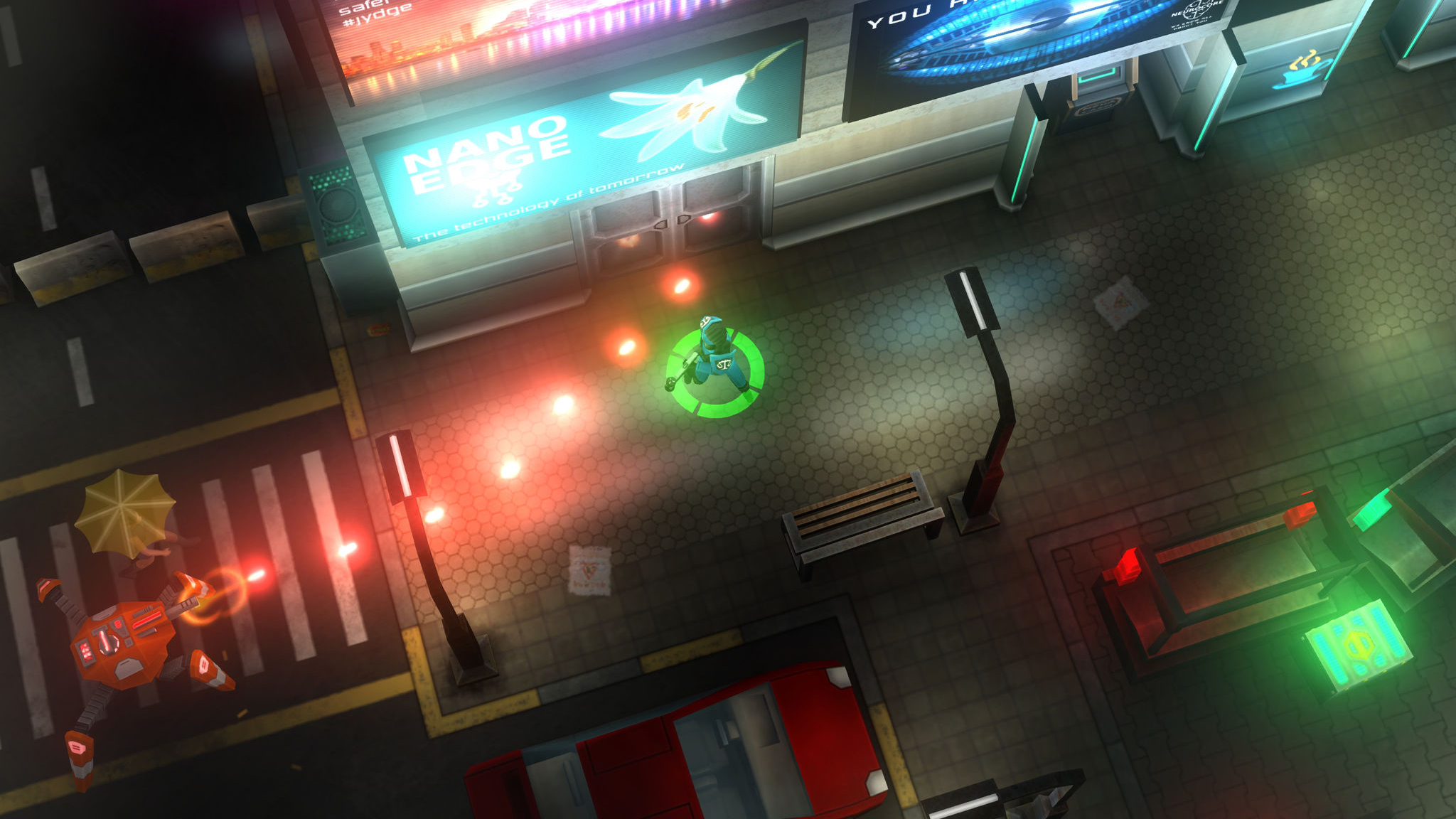
Jydge ($8.99/£8.99/AU$13.99)
Jydge plonks you in a grubby, neon-lit dystopia, with nasty ideas about law enforcement. As the titular ‘jydge’, you go on missions that largely involve shooting bad guys, ‘confiscating’ loot, and rescuing the odd hostage.
The anything-goes nature of Jydge initially wrong-foots, because the viewpoint and setup scream stealth shooter. You think you’ll be sneaking about, like a ninja with a gun. In reality, it’s often more like a brains-free twin-stick blaster.
That said, Jydge does have some tactical nous when it comes to challenges that are initially impossible. Actions can affect levels permanently, meaning with a little thought – and quite a lot of violence – you can by way of a few ‘stacked’ attempts in fact clear a tricky scene in 20 seconds, assuming your thumbs can keep up as you revel in the mayhem.

Space Junk ($0.99/£0.99/AU$1.49)
Space Junk is what happens when someone rethinks classic arcade blaster Asteroids and goes all-out, souping it up for the iPad. The basics remain: you’re floating in space, blowing everything around you to smithereens. Big things, when blasted, split into smaller things. UFOs take occasional pot-shots. Anything that hits you kills you.
But everything’s handled with such grace and good humor that you can’t help but be enthralled. The controls – despite being dreaded virtual buttons – work nicely, aided by subtle inertia on your little spaceman.
For those who prefer precision over random blasting, there’s a bonus for careful shots. And even the varied level names and themes raise a smile, such as ‘So Long, Space Shuttle’ (blowing NASA’s finest to bits) and ‘Victorians Got Here’, with its steampunk space stations.

No Stick Shooter ($1.99/£1.99/AU$2.99)
Mobile gaming’s early days featured all manner of straightforward shooters that had you desperately fending off hordes of aggressors coming from above. No Stick Shooter recalls Space Invaders, in enemies heading downwards towards your defenses, but also Missile Command, in that your weapon’s rooted to the spot, and success depends on precision shooting.
However, unlike those games, No Stick Shooter is a resolutely modern affair. On selecting a weapon, shots are unleashed by tapping the display. For a very brief period, this is quite a leisurely process, picking off asteroids.
But the game soon bares its teeth, flinging all manner of neon foes your way, which must be defeated by deft fingerwork and tactical weapon selection, including crackling lightning and gigantic red laser beams.
On an iPhone this is a terrible game because it’s too fiddly; but on an iPad, No Stick Shooter is a wonderful, vibrant, thrilling shoot ’em up that’s not to be missed.

Steredenn ($3.99/£3.99/AU$5.99)
Steredenn is an endless horizontal shooter, infused with the beating heart of the best retro blasters around, topped off with a head-nodding guitar-laden soundtrack.
Unlike most games of its ilk, it works brilliantly on iPad. The responsive controls have you drag the left of the screen to move your ship, and tap the right to fire at incoming waves of enemies. A flick of your right thumb switches weapons, and if your ship darts beneath a digit, crosshairs pinpoint its position.
And you’ll need that knowledge at all times, because enemies come thick and fast in all their chunky-pixel glory. But so too do power-ups – and learning the effectiveness of weapons against specific opponents boosts your long(er)-term survival.
Well, that and sometimes bolting a massive whirling saw blade to your ship, like some kind of space lunatic. It’s superb, raucous, shooty fun.

Death Road to Canada ($13.99/£13.99/AU$21.99)
Zombies have taken over the USA, and so it’s road trip time in Death Road to Canada, the aim being to flee to the safety of the land of the moose. The tiny snag: the aforementioned zombies, and the fact you start out in Florida.
The game itself is an action-oriented role-playing title, switching between top-down shooting/scavenging scenes, choose-your-own-adventure text sections, and claustrophobic and downright terrifying sieges that lock you for a set time in a confined space with hundreds of the undead.
Actually, it’s not that terrifying, given that Death Road to Canada looks like a game from the 1990s. But it is excellent fun, despite some slightly slippy virtual controls. (If you’ve an Made for iPhone controller, use that to boost your zombie-killing prowess.)

Darkside ($1.99/£1.99/AU$2.99)
In the inky blackness of space, humans have started mining massive space rocks, and it turns out aliens have a big problem with that.
Enter: the hero of Darkside, who has to blow up said aliens and, for some reason, all the rocks the humans are supposed to be mining. Videogame logic!
It all comes across like someone gleefully mashed together two classic arcade titles – Asteroids (shoot rocks until they’re tiny enough to obliterate) and Robotron (the original twin-stick shooter) – and wrapped the result around beautifully rendered planetoids.
Although there’s a free version, splash out for the paid release and you get smart bombs in the arcade mode, and two extra modes to try: one being mission-based, and the other being a tough endless mode for cocky veterans.
The end result is tons of shooty fun that’s accessible enough for newcomers, but that provides a stern test for even the swiftest of trigger fingers.

Tanks! - Seek & Destroy ($2.99/£2.99/AU$4.49)
One of the earliest 3D games was Battlezone, a tank warfare title at the time so realistic the US military commissioned a version from Atari to train gunners. iOS tribute Vector Tanks was subsequently gunned down by Atari lawyers, but its DNA survives in Tanks! - Seek & Destroy.
Like Battlezone, Tanks pits you against an endless number of vector tanks, on a sparse battlefield. But this is a much faster, tougher game, with tilt-and-tap controls that put you more in mind of console racing games than a stodgy tank 'em up. The result is a relentlessly thrilling 3D shooter that marries the best of old-school smarts and modern mobile gaming.

AirAttack 2 ($0.99/£0.99/AU$1.49)
You get the feeling creators of classic vertically scrolling shooters would sit in front of AirAttack 2 in a daze, dumbfounded at what's possible on modern home-computing devices.
That's not down to the gameplay, though: like its predecessor, AirAttack 2 is a straightforward shooter - you're piloting a fighter in World War II, downing enemies while optionally yelling "tally ho" at an annoyingly loud volume.
But this World War II is decidedly different from the one that occurred in our reality: Germans own limitless squadrons and building-sized tanks (versus the Allies, seemingly relying on a single nutcase in a plane to win the war).
It's the jaw-dropping visuals that really dazzle, effortlessly displaying swarms of enemies to down, colossal bosses to defeat, and a destructible environment to take out your frustrations on. For the low price (not least given that there's no IAP whatsoever), it's an insane bargain.
Our favorite iPad extreme sports, soccer, tennis, golf, and management games.

Football Manager 2019 Touch ($19.99/£19.99/AU$30.99)
Football Manager 2019 Touch brings the bulk of the famous PC game to your tablet. You take the reins of a real-world soccer club, and try to ensure they don’t get a kicking – all by way of your tactical savvy and cunning player transfers.
If you’ve not played before, this game has depth. It’s easy to feel swamped and overwhelmed as you work your way through the menus and options. But this is complexity married with friendliness – there’s some optional automation, and the overall experience feels more streamlined than the PC original.
The main niggle is there aren’t many changes from 2018’s release. If you own last year’s game, don’t put in for a transfer just yet; but if you’re new to Football Manager on iPad, there’s no more compelling soccer management to be found on an Apple device.

Desert Golfing ($1.99/£1.99/AU$2.99)
Desert Golfing is about the most minimal take on golf imaginable. The side-on game gives you a tee and a hole to reach. You drag to aim and set power, and then take your shot. Smack your ball out of bounds and you start from scratch; make the hole with one or more shots and you can continue.
It feels never-ending, as you find yourself dozens and then hundreds of holes in, and it should get boring – but it really doesn’t. Your scorecard builds but ceases to have meaning as you relax into a hypnotic chill-out take on a sport that wasn’t exactly frenetic in the first place.

Motorsport Manager Mobile 3 ($3.99/£3.99/AU$5.99)
Motorsport Manager Mobile 3 is a racing game that has you holding the purse strings rather than the steering wheel. So instead of coaxing your car around complex turns, and blasting along straights, you manage your drivers (and their egos), plan HQ and car upgrades, and figure out when during races they should push their engines or change their tires.
The game’s sense of balance is very smart. It’s immediate and intuitive enough for newcomers, with a gentle first season, but gradually unlocks complexity, depth, and challenge to make you stick around for the long term.
And although races merely feature colored discs whizzing round diorama-like circuits, they are nonetheless tense, exciting affairs – not least when one of your drivers is vying for a podium finish.

Super Stickman Golf 3 (free + IAP)
If you find golf a bit dull, Super Stickman Golf 3 offers a decidedly different take on the sport. Instead of rolling greens, a sprinkling of trees and the odd sandpit, golfers in this bizarre world pit their wits against gravity-free space-stations, floating islands, and dank caverns with glue-like surfaces.
The game's side-on charms echo Angry Birds in its artillery core, in the sense that careful aiming is the order of the day. But this is a far smarter and more polished title, with some excellent and imaginative level design.
With this third entry, you also get the chance to spin the ball, opening up the possibility of otherwise impossible shots. And once you're done with the solo mode, you can go online with asynchronous turn-based play and frenetic live races.

Table Tennis Touch (free + IAP)
Table Tennis Touch brings ping pong to your iPad in glorious fashion. You get a set of training mini-games, to hone your aim and power, after which point you can delve into a full career mode.
Matches involve you taking on a levitating bat rather than an actual person on the other side of the table. The places in which you play, though, are beautifully rendered, although your focus will mostly be on the tiny white ball being belted around as you smash and spin your way to the big leagues.
This aspect of the game feels the part, capturing the speed and intensity of a properly gripping ping pong rally – and all without those moments where you subsequently step on and crush the ball like an idiot.

Touchgrind Skate 2 ($6.99/£6.99/AU$10.99)
Touchgrind Skate 2 presumably had a development process that began with someone realizing fingers look like legs if you put a tiny skateboard underneath them. And that’s what you get here – a virtual board, which you control with two digits.
Although that might feel gimmicky, it’s intuitive. But don’t mistake Touchgrind Skate 2 for an arcade pushover. As you roam urban locations, tasked with performing gnarly stunts, you’ll wipe out – often.
What you must do is learn to master the board, and then slowly chain together tricks. Only then will you get enough points to unlock new parks. On iPad in particular, this works very well, the larger screen giving you space to breathe. And it’s a great example of touchscreen innovation and physical interaction — Touchgrind Skate 2 just wouldn't be the same with a gamepad.
Our favorite iPad card games, turn-based strategy titles, and digital board games.

Tropico ($11.99/£11.99/AU$17.99)
Tropico is a dictator simulator masquerading as a strategy game. Well-known to PC players, Tropico finds you in control of a Caribbean island – and aiming to stay in power at all costs.
The free-form nature of the game affords you various routes to dealing with your people. Resources must be carefully balanced, so you can build the structures that will make hard cash, and keep people entertained and healthy. And if everything kicks off, you must quickly figure out the best way to deal with uprisings.
On iPad, this could all have been a complex mess, but the interface has been cleverly redesigned for touch, providing fast access to key commands through your ‘Dictator’s Desk’. It’s a great addition to a classic title – one that fully showcases the power that’s in the hands of any gamer armed with an iPad.

Kingdom Rush: Vengeance ($4.99/£4.99/AU$7.99)
Kingdom Rush: Vengeance is the latest iteration of the best tower-defense game on mobile. This time, you get to play bad guy Vez’nan – a wizard tired of getting repeatedly beaten, and determined to conquer the kingdom.
How conquest and tower defense align is hard to say, but it makes for a great game. As ever, you drop towers in pre-defined spots, unleash special powers, and send a mighty hero into the fray for ad hoc smashing.
Like other entries in the Kingdom Rush series, Vengeance looks great, is finely balanced, and keeps things interesting with new surprises. There is one bad surprise, though, in IAP stinking up the place a bit. However, have patience, learn from your mistakes, and avoid temptation, and you’ll find there’s no need to pay more – right through to Vez’nan’s final victory.

Twinfold ($3.99/£3.99/AU$5.99)
Twinfold is a procedurally generated dungeon-crawling survival game, masquerading as a sliding puzzler. Or perhaps the reverse. Anyway, it’s really very good, although it does have an awful lot going on.
The basic goal is to keep merging golden idols to increase their value, while simultaneously avoiding angry faces and/or smashing them into walls. Eat an idol and your XP and health go up, but then all the walls in the maze change, holes appear, and new enemies join the fray.
Twinfold is quite the juggling act, but one with a cleverly conceived mix of immediacy and depth. The basic concept is easy to grasp, but in order to master the game and have any chance of relatively long-term survival, you must figure out all its quirks. Doing so is well worth the effort.

Reigns: Game of Thrones ($2.99/£2.99/AU$4.49)
Reigns: Game of Thrones marries a swipe-based card interface, kingdom management and a hit TV show. Taking the role of a claimant to the Iron Throne, you rule the Seven Kingdoms with a single digit. Swipe left or right to respond to what’s asked of you, and your fortunes with the bank, people, army and church shift and change accordingly. Fail to balance them, and you’ll be brutally killed.
Given that Reigns: Game of Thrones was designed for one-thumb play on a phone, it’s interesting to discover that it’s excellent on iPad. Instead of a blown-up iPhone interface, you instead get a visually arresting ‘widescreen’ take; and the game’s surprising depth makes it suitable for longer gaming sessions while you’re sitting on your own iron throne (or, if you prefer, a nice comfy chair).

Euclidean Skies ($4.99/£4.99/AU$7.99)
Euclidean Skies is the follow-up to the superb Euclidean Lands, a turn-based strategy game that takes place on floating constructions akin to Rubik’s Cubes. In that title, manipulating the landscape is as important as the physical moves the protagonist makes – and that’s even more overt in this sequel.
In Euclidean Skies, each individual ‘block’ within the landscape has the potential to be spun about any axis. This provides scope for brain-bendingly complex solutions, whether battling a gigantic monster by obliterating its spine with rotating chunks of land, or gradually unraveling what was once a flat surface, creating ‘arms’ to prod switches and fashion bridges to doors.
This isn’t an easy game, but it is hugely satisfying when you crack one of its puzzles. And, like the original, it also feels unique, which alone makes it worthy of consideration.

FTL: Faster Than Light ($9.99/£9.99/AU$14.99)
FTL: Faster Than Light is a real-time strategy game that finds you hurtling through space, trying to get essential data to the safety of the federation. Unfortunately, you’re being pursued by shooty rebels, and so must keep jumping to new sectors.
Every time you do, surprises await – you might make some cash, or end up in a frantic scrap with pirates. During action scenes, you direct your crew to make repairs, and fling explosives and lasers in your enemy’s general direction. At any point, you can pause to take a breather and strategize a bit.
The game is procedurally generated, and so every mission is different. But there are some constants: pitch-perfect controls, a sense of immersion, and palpable tension when half your ship’s on fire but you know one carefully aimed shot will obliterate your foe.

Infinite West (free + $1.99/£1.99/AU$2.99 IAP)
Infinite West casts you as a cowboy in the wilderness, taking down a gang that murdered his family. That hackneyed scenario might put you in mind of a shoot ’em up, and so it’s a surprise to find Infinite West is more like chess – only with pieces shooting each other.
The turn-based play across semi-randomized levels forces you to consider every action. Your gunslinger can only move one space horizontally or vertically at a time, and each foe has unique weaponry ranges. Further complexity comes from a health counter, a ‘dash’ power and an ongoing upgrades system.
There are echoes of Square Enix’s GO games, but if anything Infinite West has more depth and brains. You’ll certainly need your wits about you when, many levels into a mission, you suddenly find yourself faced with a dozen gang members intent on your untimely demise.

Sid Meier’s Civilization VI (free + $59.99/£54.99/AU$89.99 IAP)
Sid Meier’s Civilization VI properly showcases the iPad’s potential as a gaming device. Previous takes on Civilization for iPad have been weirdly cartoonish and simplified. Not Civilization VI – this is the game you get on PC, with all its inherent depth and complexity.
This means you get one of the finest 4X (eXplore; eXpand; eXploit; eXterminate) games around. You aim to make your civilization dominant by becoming a trading giant, heading to the stars, or getting all stabby/shooty until no-one else is left standing.
The game demands time and attention, is hugely rewarding, and should keep you going for months. Just as well, given its price tag. Still, you get 60 moves for free, and ‘proper’ games cost real money.
Bar some slightly blurry visuals on iPad Pro, this is the real deal – one of the best games in existence, carefully optimized for the touchscreen.
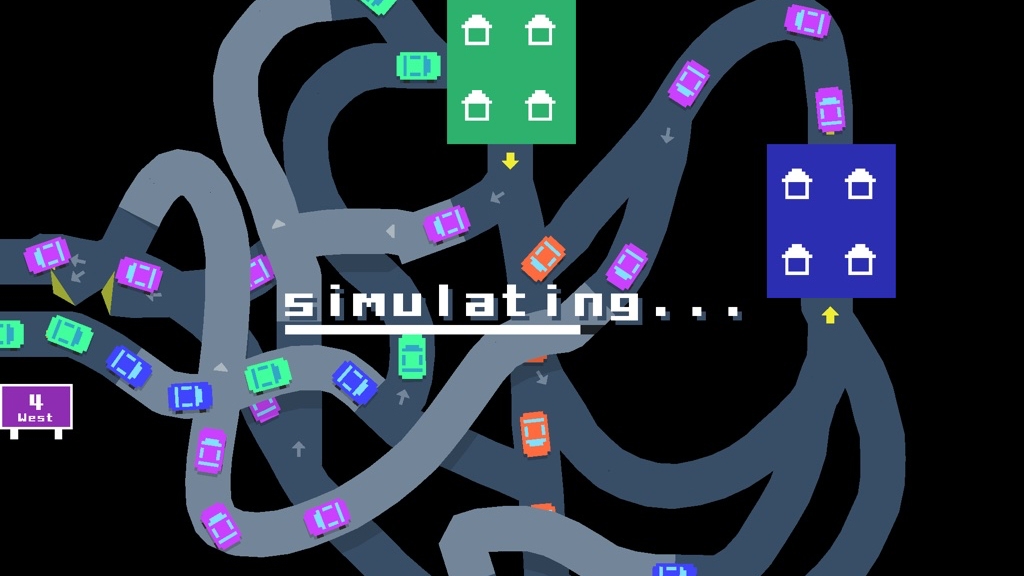
Freeways ($2.99/£2.99/AU$4.49)
Freeways explores interchange design for autonomous vehicles, which sounds deathly dull. It isn’t. Just as Mini Metro coaxed something gorgeous and essential from underground railway maps, so too does Freeways create a hugely entertaining game from the drudgery of urban planning.
Each map sector provides you with highways that must be connected to each other. Hold a sign and you get an idea of traffic flow and the links you must make. You then scribble roads down, adding overpasses and increasingly complex routes when the realization dawns about how tough this task can be.
The drawing tools and visuals are crude, and there’s no undo – mess up and you must start that particular section of the map from scratch. But the underlying gameplay is enthralling, not least when you tap ‘simulate’ to watch your layout’s traffic move in fast forward, hoping to avoid a dreaded traffic jam.

Card Thief ($2.99/£2.99/AU$4.49)
It takes quite a lot to make a solitaire game tense, but Card Thief manages, mostly by smashing dealing out cards into turn-based stealth-oriented puzzling.
As the titular villain, you map out pathways across the cards on the screen, figuring out how to grab loot without losing too many stealth points, which are depleted on battling adversaries.
Repeat play is rewarded by improving your strategies, unlocking new kit to help increase your score, and eventually finding your way to new missions with different foes.
Like any take on solitaire, Card Thief does get a bit repetitive, but this is also a game you’ll be able to happily play a round of a day for many weeks, gradually improving your ability to sneak about and become a master pickpocket.

Concrete Jungle ($4.99/£4.99/AU$7.99)
Most city building games are about micro-management – juggling budgets, people’s demands, and limited space. But Concrete Jungle rethinks the genre as a brilliant brain-bending puzzler. And here, restrictions regarding where you can build are of paramount importance.
At any point, you have seven rows with six lots where you can place a building. Said buildings are served semi-randomly from a card deck. Each column needs to have enough housing points for it to vanish and unlock more space on which to build. The snag: other buildings boost or reduce the points allocated to adjacent lots.
You must therefore take great care to place your factories (bad) and parks (good), realizing that any complacency may be severely punished several moves down the line, when you suddenly find yourself faced with a slum of your own making.

Mini Metro ($4.99/£4.99/AU$7.99)
Traveling on underground railways can be a fairly hideous experience, which is perhaps why Mini Metro is such a pleasant surprise. The game is all about designing and managing a subway, using an interface akin to a minimal take on the schematics usually found hanging on subway walls. And it’s glorious.
Periodically, new stations appear. You drag lines between them, and position trains on them, in order to shepherd passengers to their stops. All the while, movement generates a hypnotic, ambient soundtrack.
Over time, things admittedly become more fraught than during these relaxing beginnings. The demands of an increasing number of passengers forces you to juggle trains and rearrange lines until you’re inevitably overwhelmed. But the nature of the game is such that this never frustrates – instead, you’ll want to take another journey - hugely unlike when suffering the real thing.

Solitairica ($3.99/£3.99/AU$5.99)
RPG combat games usually involve doddering about dungeons with a massive stick, walloping goblins. But in Solitairica, cards are your weapon; or, more accurately, cards are the means by which you come by weapons.
Your aim is to trudge to a castle, defeating enemies along the way. You do so in a simplified solitaire, where you string together combos by removing cards one higher or lower than your current card. Doing so collects energies used to unleash defensive or offensive spells.
Unfortunately, your enemies also have skills, and survival requires a mix of luck and planning to defeat them.
This involves managing your inventory so you're always armed with the best capabilities, while probably simultaneously wondering why the hero didn't arm themselves with a bloody great sword rather than a deck of cards.

Exploding Kittens ($1.99/£1.99/AU$2.99)
High-octane card games don’t seem the greatest fit for iPad gaming, but Exploding Kittens perfectly captures the manic chaos of the Oatmeal-illustrated original. As per that version, this is Russian roulette with detonating cats.
Players take turns to grab a card, and if they get an exploding kitten, they must defuse it or very abruptly find themselves out of the game.
Strategy comes by way of action cards, which enable you to peek at the deck, skip a turn, steal cards from an opponent, and draw from the bottom of the deck “like the baby you are”.
Local and online multiplayer is supported, timers stop people from dawdling, and a ‘chance of kitten’ meter helps everyone keep track of the odds. Large hands of cards rather irritatingly require quite a bit of swiping to peruse (although cards can be reordered), but otherwise this is first-rate and amusingly deranged multiplayer mayhem.

Warbits ($4.99/£4.99/AU$7.99)
Nintendo fans probably wonder why the big N hasn't yet brought the superb Advance Wars to iPad, but Warbits now scratches that particular itch. However, although Warbits is influenced by Nintendo's turn-based strategy title, it isn't a copy — the iOS game brings plenty of new thinking to the table and is very much optimised for the iPad.
Working with 16 varied units, you conquer a series of battlefields by directing your troops, making careful note of your strengths and the enemy's relevant weaknesses. All the while, Warbits merrily has you and your opponent trading barbs, often about subjects such as whether tomatoes are fruit, because that's the kind of thing you'd go to war over.
Finish the 20-mission campaign and you'll have a decent grasp of Warbits, and can then venture online to take on other human players across dozens of different maps. With superb visuals, enough new ideas over the game that inspired it, and a single one-off price-tag, Warbits is a must-buy for any iPad-owning strategy nut.
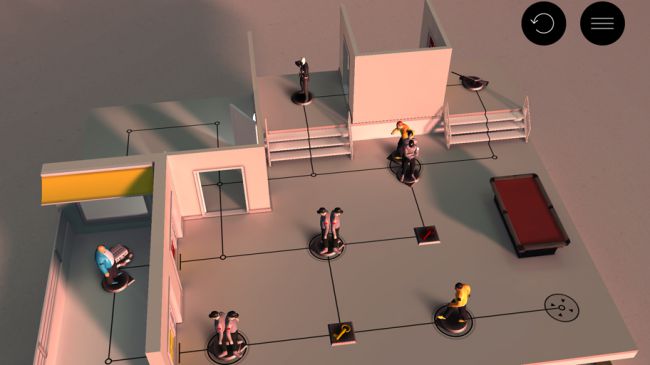
Hitman GO ($4.99/£4.99/AU$7.99)
It's great to see Square Enix do something entirely different with Hitman GO, rather than simply converting its free-roaming 3D game to touchscreens. Although still echoing the original series, this touchscreen title is presented as a board game of sorts, with turn-based actions against clockwork opposition.
You must figure out your way to the prize, without getting knocked off (the board). It's an oddly adorable take on assassination, and one of the best iOS puzzlers. There's also extra replay value in the various challenges (such as grabbing a briefcase or not killing guards), each of which requires an alternate solution to be found.

Rome: Total War ($9.99/£9.99/AU$14.99)
Rome: Total War revamps a much-loved and genre-defining strategy classic for your iPad. You start the game as one of six factions, aiming to throttle enemies and conquer the known world. To succeed, you must wield your tactical brain, as well as demonstrating diplomatic and fighting skills.
You might wonder whether complex battle simulators can really shine on iPad, but creators Feral Interactive fully optimized the game for touch. And there’s something special about freeing yourself from sitting in front of a PC, and instead peering at a 3D battlefield with thousands of units, all while curled up on the sofa.
Our favorite iPad games that have you battle with crosswords, anagrams, and letters.

Sidewords ($2.99/£2.99/AU$4.49)
Each puzzle in Sidewords starts with an empty grid that has words along its top and left edges. You select letters from both to create new words. Each chosen letter shoots a line into the grid, and the squares where those lines meet become solid blocks, which display the words you’ve created.
The idea is to fill in every square on the grid. This is easier said than done – you might consider yourself a genius on finding a massive, extremely clever word, but later find your grid peppered with tiny gaps. Completed words can be removed with a tap at any point, Sidewords clearly wanting you to experiment and try new things on your way to a solution.
It’s a great concept – immediate, fresh, and also very challenging when you start tackling larger grids.

Supertype ($1.99/£1.99/AU$2.99)
Supertype is a strange word game, in that it’s primarily interested in the physical form of letters and how they interact in animated 2D environments. Each puzzle tasks you with using the letters to collide with dots that are littered about – you type some characters, press the tick mark, and watch as everything starts to move.
One puzzle has a dot up some stairs, and is easily dealt with by placing a lowercase l on each step, and a p to knock them all down. Elsewhere, you use letters to swing from the scenery like tiny action heroes, or roundish characters that rain down like a typographic avalanche. It’s great stuff – imaginative, original, and definitely not yet another Scrabble clone!

SpellTower ($2.99/£2.99/AU$4.49)
There’s something gleefully classic about SpellTower. It marries very old-school word games – in the sense of paper-based crosswords and word searches – with much-loved arcade puzzlers. The result is the best word game on iOS.
Tower mode has you face a stack of letters, tapping out snaking words that disappear when submitted, the tiles above then falling into the gaps. A keen sense of planning is required to balance letter stacks and ensure tiles aren’t left stranded.
Additional modes soon open up: Puzzle adds a new row of letters for every word you submit; Rush throws in a timer; and Debate pits two players against each other. iPad Pro owners also get Super Tower mode, offering a colossal 432 tiles and the potential for blockbuster scores – if you can find the right words lurking within the jumble.

Puzzlejuice ($1.99/£1.99/AU$2.99)
Puzzlejuice shoves Tetris and SpellTower into a blender, adds a load of power-ups, and leaves you – the somewhat bewildered player – to make sense of the chaos. It’s entirely appropriate that the game states it will “punch your brain in the face”.
It starts with The Tetris bit, falling blocks being used to create lines. But complete lines don’t vanish – they turn into letters. Tapping blocks of color gets you further letter tiles. You then find words snaking through the jumble to submit, freeing up room for new shapes falling into the well.
On iPhone, it’s all a bit too fiddly to be fun; but the iPad’s extra acres transform Puzzlejuice into an entertaining and quirky genre mash-up.

Scrabble Premium ($9.99/£6.99/AU$10.99)
Scrabble Premium [US store] | [non-US stores] is the famous word game on your Apple tablet. You and your opponents use dished out letters to gradually build a crossword. Cleverly utilizing a combination of show-off big words and/or score-boosting board tiles will have you zoom ahead of opponents, who’ll hate you for repeatedly placing the Q in qi on a triple letter tile.
On the iPad, the game works nicely, displaying the complete board without scrolling, and at a finger-friendly size. It includes a dictionary, and chat for when playing human opponents. Computer players exist, too, although they do love using bafflingly obscure words – and chastising you when you fail to do the same, which isn’t very congenial (12 points).

AlphaPit ($2.99/£2.99/AU$4.49)
AlphaPit is a cleverly designed word game based around grids of letters. The aim is to remove them all. The snag is that the letters are jumbled up, and you must therefore strategically remove words, otherwise you can end up with tiny islands of characters that are impossible to use.
Fortunately, the game provides you with special powers to ease your progress: you can shuffle letters, undo an error, or merrily blow up a tile that’s getting in your way. But the smartest bit about the game is when you realize these are all hand-crafted puzzles. AlphaPit isn’t random – it’s all about you finding the best solution for any given problem.
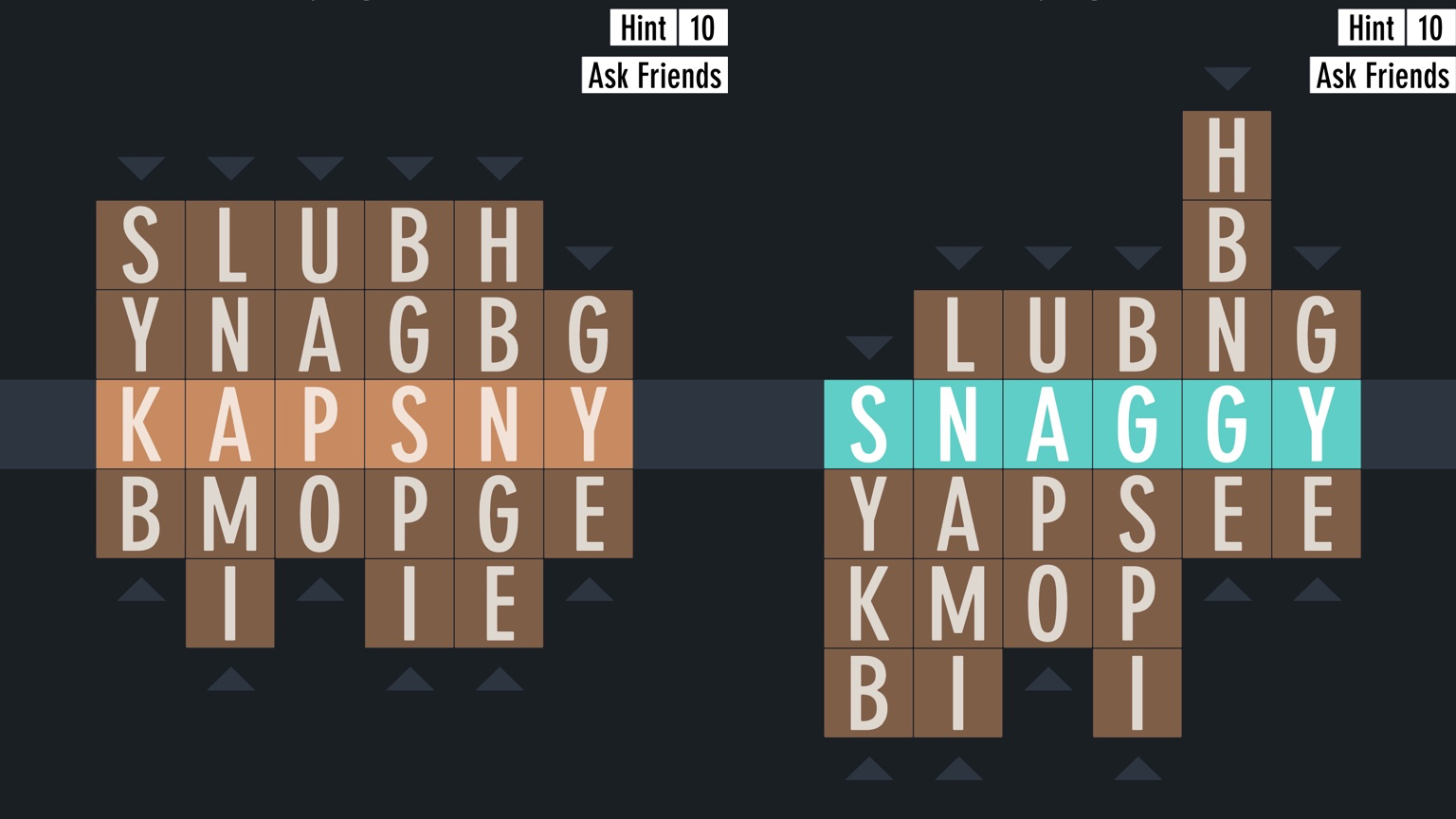
Typeshift (free + IAP)
Typeshift at its core is a mix of traditional word games that you might find in a newspaper – crosswords; anagrams; word searches. But this is all presented on your iPad in an ultra-modern mix of minimal visuals and swish tactile gameplay.
The basic idea is to slide columns of letters up and down, to make complete words in the central row. Do this and the letter tiles change color. Change them all to complete a puzzle – unless you’re playing one that also requires you to match completed words to crossword clues.
Each puzzle is hand-crafted, and they’re sold in sets. But even if you don’t fancy splashing out too often, TypeShift gives you a new puzzle every day. Either way, it’s a must-install.
from TechRadar - All the latest technology news http://bit.ly/2CZ2wkA
via IFTTT

